-
Posts
257 -
Joined
-
Last visited
Content Type
Profiles
Forums
Gallery
Events
Posts posted by The Bitter End
-
-
11 hours ago, JSGerson said:
Thank you for this Jon
This drawing has been a great addition and I have pored over it for ages. For what its worth, I agree with your transcription. I wonder what they mean by chamfering of black strakes. If it had just said Wale I would have been less confused.
Keep these drawings coming whenever the urge hits you, I love them. -
12 hours ago, Marcus.K. said:
Oh, Gentlemen, pls. be very careful with Karl-Heinz Marquardt´s Constitution. Marquardt did a lot of very interesting and excellent research in many fields of ancient sailing vessels. His AotS Constitution book is unfortunatly not a highlight - and I have the impression that its - unfortunatly - perfect presentation and the huge impact of the author´s name did damage a lot to the general view on the ship and caused a lot of errors to so many good model builders.
Let me pls. try to help here.
First of all: there is of course no doubt that the ship had wales - as I understood Haiko he is looking for how to shape the upper and lower edge of them: an invisible transition between the heavy wales and the thinner planking – achieved by gradually diminishing the thickness at the edges – or a sharp transition with a distinct arris or a chamfer.
Second: that section cuts you showed, Haiko, are from one drawing - in which - in the gun deck level - two texts explain the content of each half:
Left side is "Port side - present construction and arrangement" - so this is what Lord found in 1925-26 from the 1906 renovation.
Right side of the drawing: "Starboard side - proposed re-construction" ..
Above the header of that drawing #34535 is a text explaining that the drawing is based on "considerable research" and even if the text on gun deck says "Proposed reconstruction" we need to be careful - as the final result differed.
These are the two half section cuts to showed in your post, Haiko. And below you find the text right of that section cuts - above the drawings header.
This next photo done in 1927 shows what Lord was finding from the 1906 renovation:
I believe we can not identify for sure which planks were the thicker wales - and which were just planks, can you?
But there is another drawing - #35208 - in which Lord seems to represent the "from Specifications .. Joshua Humphrey "as the note close to Lords signiture explains.
Unfortunatly I can not read that text above the header.
Does anyone of you have a copy of that drawing #35208 - with a readable "note" above the header?
This here is a copy of that drawing #35208 as it is represented in Magoun´s "Old Ironsides and other historic ships" - unfortunatly without that note and the header.
And then there is this last section cut of the Lord Restaurtion (I know about) #24472 - done in 1931 "as finished" - which represents what we would find in 1931 ..
I did not (yet) find any represenation of the ship in which the wales would look like the britsh "puzzle" with these short "pentagon"-shaped pieces as Marquardt shows in his unfortunatly beautiful book. It is much more likely that the US Frigates had - from beginning until today - more simple but robust and long planks as wales as there never was lack of long wooden planks in the US - in contrary to their British cousins - which had to deal with shortage of wood in the 1800s.
Looking through all the representation I collected of US Frigate Constitution or her sister ships I never could identify an "edge" of the wales. Either it was that tiny that it was not obvious enough - or it just wasn´t existing. Here an example for 1871:
The artist did show all kind of ugly things - like that ****-ramp on the bow or the tiny air vent in the quarter gallery. Many strange and ugly details. Would he miss distiguisable wales?
Or here: in 1857:
No wales visible - which does not at all mean they were not existing.
Just: there is no edge notable.
Another approach - from technical point of view:
an edge would make no sense - neither on top nor on bottom side of the wales.
On bottom side it would just increase friction in the water.
On top and on bottom side it also would be endangered to get damaged, while doint what wales have to do: being a bumper for any object floating against the ships hull. And if an edge was damaged, the wood would be in much more danger to start rotting. So high risk.
And how to repair? You had to remove a plank out of the hull!
What would be the benefit of a sharp edge? .. or even a chamfered edge?
Technically it would make no sense to have the wales not smoothened to the planks. Any other feature to protect the hull from impacting objects like fender strakes for the loading or for the action with the boats - or billboards for protecting the hull from the ancres.. Those were added on top of the planks - and were easy to remove if demaged or rotten.
In my opinion those planks being the wales were just thicker - but you would not be able to differentiate them - except maybe by a bit wider? - but I don´t see evidence for that either. I would not represent them in the ship as an extra layer or as thicker planks with a distinguishable edge.
Marcus my friend
A woderful and well thought out response as always, I have wavered considerably during this investigation and I must say I tend to lean toward your thinking around the mechanics of the ship and the act that any sort of edge would be a structural flaw.
As you point out this feature is not visible anywhere on any contemporary representation of the ship and only really appears on technical drawings made much later.
I was considering doing the chamfer but I lean now far more toward an essentially smooth transition. to be fair a chamfer on a 0.5mm thick plank is basically going to look like a taper.
thank you for your effort and research. It is nothing short of a joy to me,
CheersHaiko
- Der Alte Rentner and Marcus.K.
-
 1
1
-
 1
1
-
On 9/23/2025 at 8:59 PM, GGibson said:
As long as you feel the reputation is unwarranted and not unwanted, we appreciate your input whenever there is a question, Jon!
Which is why I continue to say that I will be striving for an "1812-ish" version of the Constitution... 🤷♂️👍
If only we could all have the confidence of Ericsson who has the rigging of the constitution nailed down to its exact configuration down to the hour!
Its hard for my very OCD brain to accept that I have to make hundreds of compromises for me 1797(ish) guess at what she might have looked like. Infact the only thing I know for a fact is that it definitely wasn't exactly as I am building her. -
On 9/23/2025 at 5:57 PM, Burgundy said:
Fantastic log, I'm impressed by your level of research and attention to detail. I have no doubt it will produce a beautiful looking ship.
Thank you very much my good man!
I hope I don't disappoint. It has been a great journey so far. -
On 9/23/2025 at 5:19 PM, Der Alte Rentner said:
I feel certain that you will be hearing shortly from our in-house historian, Jon.
I checked with the AI assistant I use most frequently, Grok. I asked him if he knew definitively whether or not the 1797 version of The Constitution had wales.
Here's his response:
"Yes, the original 1797 USS Constitution definitively included wales as a key structural element in its hull construction.
Wales—thick, longitudinal strakes of heavy planking—were standard in 18th-century warship design to reinforce the hull against stresses from guns, rigging, and sea conditions. For Constitution specifically, contemporary records from her builder, George Claghorn, and Secretary of War James McHenry confirm their installation during final assembly at Edmund Hartt's Boston shipyard. In a January 1797 progress report to Congress, McHenry noted: "The whole of the frame is raised, and is ready for planking; the wales are prepared, and it is expected will be on and fastened this month."ca2519 This places the wales' fastening just before her October 1797 launch.
As launched, the hull featured a broad yellow ocher band painted from near the hawse holes down to the top of the main wales, with the bends (lower hull) tarred black below and the upper works black above.6e94d2 Gun ports were positioned at the gun deck level and above the wales, with the original gun streak (a reinforced strake for port sills) running from just above the wales to the upper gun port sills.
Disagreements in model plans or historian interpretations might stem from later refits (e.g., 1803–1804 or 1812) that altered planking details, simplified diagrams in some drafts, or debates over exact thicknesses/locations. However, primary sources leave no doubt about their presence in the 1797 build. If you're referencing a specific thread on Model Ship World, feel free to share the link for more tailored advice!"Hello Peter!
Thank you very much for this and for your reference to the work of Marquardt. All very interesting and another opportunity to learn.
I think I am with you and monsieurs Grok and Marquardt that there were certainly wales comprised of heavy strakes. The question is now becoming more and more, how visible are these wales, somewhere between a totally smooth curve and a total step above and below. From a practical perspective, I would say that there was probably a thickened section with heavy chamfering on the corners to prevent tearout, so essentially a sort of hybrid between a curve and a step.It is so hard to really determine what to follow, in reality when trying to make an approximation of what the vessel really looked like. For one, I wont be painting her, so that is certainly wrong, but the subtleties of the choices made by the ship builders on the day are sadly impossible to know, but make a great opportunity for discussion and interpretation.
Cheers!
Haiko
-
Good evening All
After a bit of a break to focus on redoing the farm website as well as the labours of preparing for the summer season I am back at work on the important stuff.
I dove right back into planking and quickly ran into some problems and then some more problems.
firstly, the wale.
In my attempt to pursue historical accuracy I did a little research on what the wale might have appeared like in 1797 and came across the following very confusing information...
1. the 1926 lord cross section drawings: Starboard side(presumably showing what the restorers were meant to built to). Note only one lip on the wale upper edge
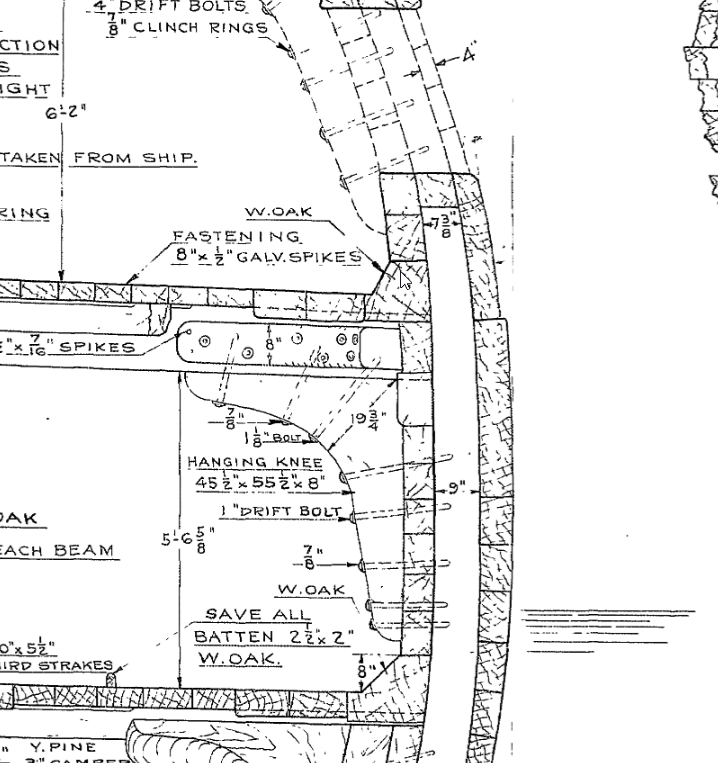
2. 1926 Lord cross section, same drawing, Port side, presumably as found?? smooth hull no Step on the wale
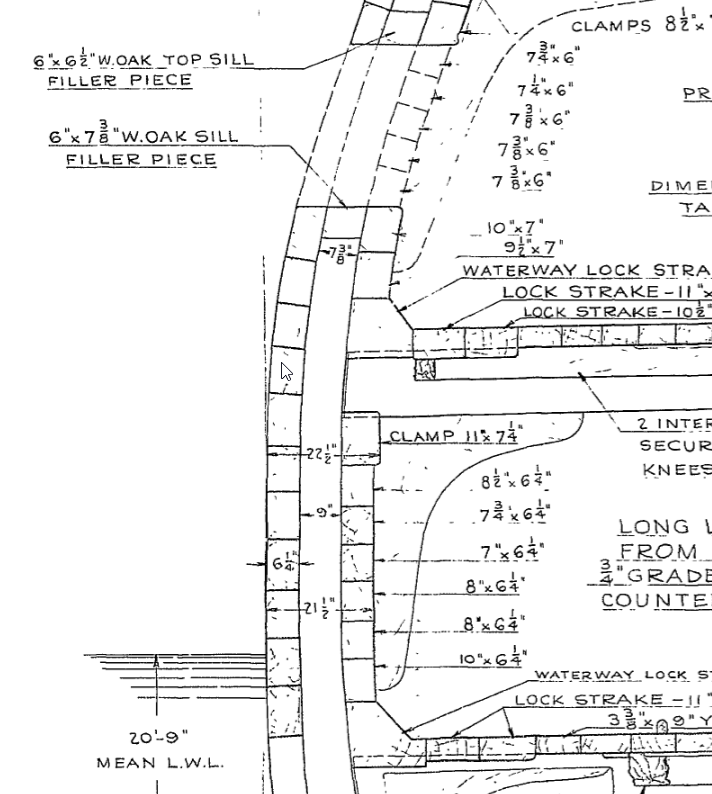
3. yet another lord drawing showing an upper and a lower step with a protrusion of 1 to 1.5 inches
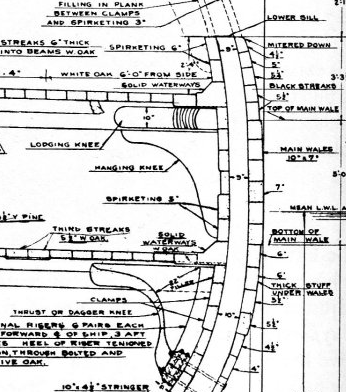
4. The hull model from 1812 showing what appears to be a totally smooth hull....this model pays alot of attention to other details so it would surprise me if this feature was there but was not shown in some form.
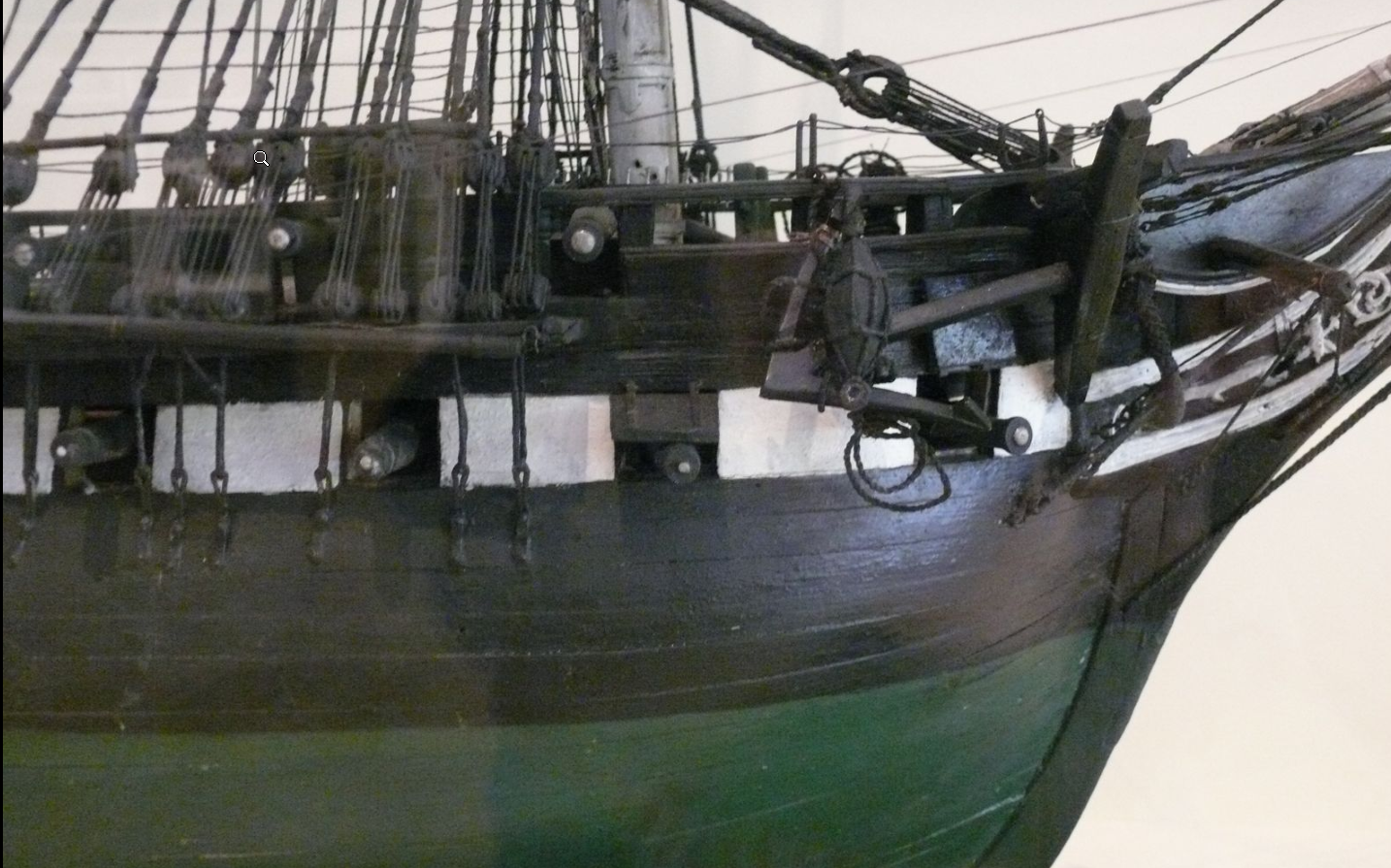
5. and finally the humphreys plans which appear to show some wort of wale like markings but that is by no means a definite
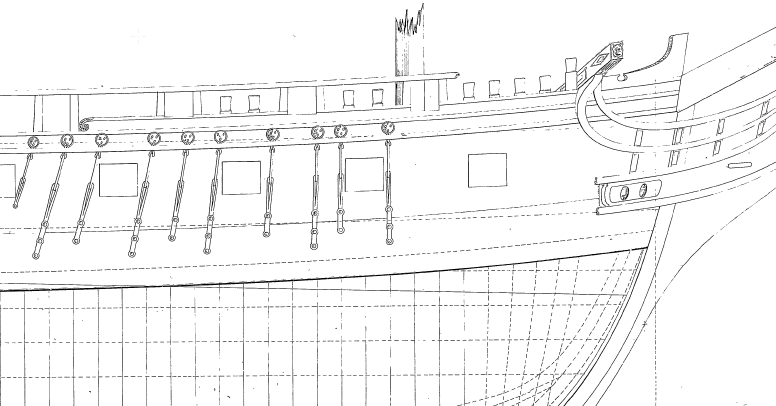
It is of course possible that the wale was there but was just so insignificant in protrusion that it was not shown on any of the paintings or drawings of the ship from the time, while in reality still being there. The fact that Lord included this feature may also simply have been a byproduct of the fact that he simply expected it to be there based on standard practice.
I am personally unable to find any feature or piece of text which indicated the stepped wale other than the one version of the Lord drawing.
I would love to hear your views and perspectives on this.
how should the wale be represented?! Should it be there at all? and if it is, an upper and lower ledge or just the upper.
Cheers
Haiko -
On 9/21/2025 at 7:26 PM, CPDDET said:
Thank you for this, I assumed that this was just a deck planking layout but It seems that it was applied to hull planking too. I am probably going to make use of this plan coupled with the suggestion by Dziadeck below.
On 9/21/2025 at 10:37 PM, Dziadeczek said:From my personal observations of various ships, I can say that in the real world the shipwrights were less rigorous to adhere to a strict 3 or 4 butt shifts, like it is shown in various books. They were using, what was available at the moment in their yards, at the same time trying to save on the wood.
So, rarely you can see these strict patterns in the real ships.
In my opinion, you can safely butt shift your planks observing rather loosely this 4 butt shift, if you want it (also, the bigger the ship, the bigger the shift, e.g. the Victory and alike would have a 4-butt shifts, perhaps the Constitution 3 butt shifts , a smaller frigate or a brig 2 butt shifts, and so on...
PS: Also, check out this discussion:
Thank you to you too, this is a great example of how well all your contributions can help.
I have decided to go for roughly a 4 butt shift while simultaneously always erring on the side of longer planks rather than shorter planks where a question comes up about where a joint should land. this is a small detail but the intention is to show that the builders in america at the time would have had access to more abundant timber resources than their european counterparts. I have quickly found that landing on a perfect 4 pattern shift very rarely happens. a plank ending near the bow or stern can easily be extended a few feet or a oint landing too near a gun port can be shifted. quickly leading to a lost 4 butt pattern,
in short im using the 4 butt pattern as a guide while working as a ship builder would have...as far as possible.Cheers
Haiko
-
Hello Ladies and Gentlemen
I am in the process of doing my second planking on my USS Constitution. (see log in signature).
I have opted to go with a double planked hull for reasons which currently escape me.
I see most modelers allow the joints to fall on the bulkheads provided in the kit but as these have been covered I can have my joints fall wherever is most historically accurate. Does anyone have any sort of idea of how planks were staggered in terms of distances between joints and not just pattern(although I would love a reliable planking pattern too).
Dude to the short intervals between the ribs on the actual ship I guess any plan could theoretically have worked but I am really interested in achieving as much accuracy as possible, specifically focusing on how she would have looked when launched in 1797.
Any ideas would be very well recieved.
Cheers
Haiko
-
Beautiful and unique. I wish I could see it in person. Well done!
-
7 hours ago, Der Alte Rentner said:
As I said to jon, the lathe is a nice-to-have, but the dividing attachment for the mill adds an enormous amount of functionality.
However, tools, especially good ones, do add up.
And normally the bottle neck to the results is the ability of the user. So congratulations, good tools or not, you are the one steering the ship.
What exact models of lathe and milling attachment do you have?
Cheers
Haiko
-
Holy smokes I want that lathe.
-
3 hours ago, Daniel Kimmer said:
I read your post about the pear wood you were using on your ship, what did you decide to use to finish the wood? How did it turnout? I also building a ship with pear wood for the outer hull and the decking. Just curious on what was used and how it looks. Thank you in advance on a reply.
Good morning Daniel,
Thanks for your message.
I wish I could show you a proper finished product but life has been incredibly busy and I have not had a chance to actually get to the finishing part of any of my build(besides a matte aerosol varnish on the completed stern gallery).
That being said I did do some testing and I must say that the finished produced by the osmo poly-x was by far the most beautiful. This was suggested by @Mike YAnd is the result of careful testing which he did, I couldn't be happier with the results.
Here is his work
I look forward to seeing what you come up with.
Good luck!
Haiko
- Mike Y, Knocklouder and Canute
-
 2
2
-
 1
1
-
What a beautiful shot, you are doing spectacular work. I love the natural wood.
-
On 7/18/2025 at 2:44 PM, Der Alte Rentner said:
As nice as your first planking looks, I don't really think you need much by way of advice to deal with the second planking. I too have sought books on planking techniques and downloaded several articles from the MSW site. In the final analysis, I ended up incorporating techniques gleaned from other build logs.
I devoted a lot of space in my build log to planking, as you know because you've seen these. I'm not necessarily holding myself up as the expert in the field, but I think I managed fairly well. Have a second look, and see if that gets you started. You will need a proportional divider and some variation of a spreadsheet, if you want to do proper job of tapering.
It seems the tribe has spoken and everyone agrees you are the man to go to for planking advice. I will take a look through chucks instructions and read your log and see what I can come up with...
Also thanks for the advice on ropes, I will be doing some online shopping in the near future.
Haiko
-
On 7/18/2025 at 8:20 AM, Ronald-V said:
That is a very nice first layer of planking! Love the flow of it, no kinks whatsoever. Regarding how to plank. As Chuck says in the first video of the planking tutorial...he discribes the process in the Winchelsea manual. In chapter 2 I believe, so maybe take a look at that if it's something you like.
Thanks Ronald,
Exactly what I was looking for. I wasn't aware that the chapters could be downloaded on their website.
Cheers, Haiko
-
Hello Everyone
Not a terribly exciting or in depth post today. Just an update to show the first planking. There is nothing of historical significance here except for the fact that one can now more clearly see the 1707 spacing of the gun ports, which are evenly spaced below the gun ports above and the absence of a bridle port.
As some of you may know I am going with a double planking approach, the first layer being done with the supplied timber(fairly nasty stuff) and the second with pear wood(still to be cut from logs which are drying).
This approach has 2 main benefits, the first being the creation of a smooth stable shaped hull to secure the pear wood to and the second being an opportunity to learn a bit about planking. This being my second build this was much needed to hone my skills before the final planking.
I did the starboard side "correctly" besides the fact that I used single runs of planking as far as possible instead of the correct length planks as in the final layer. I did however attempted to taper the planks correctly etc. This went pretty well on the Starboard side but I somehow messed up the process on the port side and developed a strange curve in the planking. At this point I decided that it didnt make sense to keep torturing myself and completed the final planking with full width planks.
My next step is to plank below the stern gallery and then move onto the final hull planking.
All this being said...does anyone know where I can find a good complete planking tutorial. I have seen chucks great videos but they begin after the hull has been marked as far as I can tell.
T.B.E.
- Thukydides, Zarkon, Geoff Matson and 3 others
-
 6
6
-
Peter my good man, where did you get this rope? i presume the answer is in this log but I am taking the lazy route to get the information. I love the look at this scale.
Thanks,
Haiko
-
On 7/16/2025 at 3:11 PM, Der Alte Rentner said:
Thanks for checking in. Hope to see you back in action soon.
Good luck with the Orchards. Coincidentally, some nephews of mine just bought an apple orchard in a small town outside of Erie, Pennsylvania. It's very recent news to me, so I don't have much by way of details, except that I've been told it's a lot of work.
Back to the first course of planking: Remember, this doesn't have to be perfect. Use filler and sandpaper and make your life easy. And because you will have a decent foundation for adhesives, the next layer will be much easier to deal with than direct plank on hull construction.
Best
Peter
I think you are right about filler and sandpaper being my friend. I look forward to hearing about the new family orchard. I actually learned alot of what I know from the pen state university textbook on fruit farming.
Cheers!
Haiko
-
12 hours ago, Der Alte Rentner said:
We haven't heard from you in quite a while. I imagine that you're into some deep dive on some point of research and that will be seeing the result of that fairly soon?
Good Morning Peter!
Its great to hear from you, and thanks for checking in. I wish that were true but unfortunately my research has had to largely come to a standstill for now. I was hoping for a quiet winter but no such luck, the farm has been incredibly busy and we are planting a new apricot orchard, so there has been far too much to do.
I have however made some decent progress on a rough first planking layer to place the final layer over. This gives me a whole lot more respect for your fine planking on your model, even this rough planking has been a real labour intensive challenge...Hopefully I finish up soon and can post something.
At least I have been keeping a close eye on your build to get my constitution fix. Your guns are looking spectacular.
Cheers
Haiko
-
Here you go
For more than two centuries, stories have circulated along the Washington County coast: that the British burned a captured Revolutionary War schooner in Jonesport’s Sawyer Cove. Some versions were recorded in 19th-century newspapers and George Drisko’s 1904 “Narrative of the Town of Machias.” Others were handed down through families like the Sawyers.
In the 1960s, Valdine Atwood and her mother followed those stories to the shoreline. “Dorley Sawyer’s family lived nearby,” said Atwood, now a Machias historian. “And the story passed down was that they saw the Margaretta beached, saw the crew run into the woods, and saw the British come and set it afire.”
No wreck was visible on the day of their visit to the shore, but Atwood reached blindly into the mud and pulled up a piece of timber.
On their way out, they passed a white cross on the rocks.
“They used to do that to mark a shipwreck,” she said.
Atwood said she always believed the stories. Now, a multi-year archaeological study strongly supports her instincts and centuries of oral tradition — the wreck of the Margaretta likely lies in Sawyer Cove.
The area around Sawyer Cove is now private property, with no public access, but a neighboring landowner permitted the research team to work on-site.
“The wreck in Jonesport, we think, is Margaretta,” said archaeologist Arthur Spiess, co-author of a report about the shipwreck that is soon to be released by the Maine Historic Preservation Commission and the Natural Resources Conservation Service. “There’s no evidence against it, and some strong evidence for it.”
Spiess and fellow archaeologist Nathaniel King were alerted to the shipwreck in 2021, when Maine Game Warden Joe McBrine — also a local historian — heard reports of “a ship coming up out of the mud.”
“At low tide, you could see it,” recalls McBrine. “We measured it, and it was within a couple of feet of what the Margaretta would have been. I thought, ‘Man, this could really be it.’”
McBrine already knew the story well. As a member of the Machias Historical Society and a local reenactment group, he’s spent years educating the public about Washington County’s Revolutionary War-era clashes — including what some view as the first naval battle of the American Revolution, the Battle of the Margaretta.
That battle began just weeks after Lexington and Concord. On June 2, 1775, three ships sailed into Machias Bay — among them the British schooner HMS Margaretta. Their mission: to trade for lumber, forcibly if necessary, to supply British troops occupying Boston.
The residents of Machias had other ideas. They planned to capture the British officers during Sunday services, but when the British escaped to their vessel and sailed for Machias Bay, the Americans gave chase. They met in battle exactly 250 years ago, from June 11 to 12 of 1775.
The clash ended with the deaths of three Americans — John McNeil, Robert Avery, and James Coolbroth — and the injury of several others, as well as the mortal wounding of British commander James Moore and the capture of the Margaretta. The Americans soon hid the 50-ton schooner in what is now Marshfield’s Middle River.
In 1776, when Machias men judged it safe to move the vessel, they likely reballasted her in Machias — using local ballast stones that now provide one of three key pieces of evidence linking the shipwreck to the Margaretta.
“Her ballast was derived from eastern glacial till deposits,” said Spiess, “and that fits with the rumor that it was laid up for a year and refloated.”
Spiess believes the ship’s original ballast stones would have come from modern-day Massachusetts, where the vessel was likely built. The wreck’s construction also offers a critical clue.
“The way it was built was not ‘Navy fashion,’” said Spiess. “Everything’s a little bit variable. It’s a local job, not a military job, not perfect.”
https://i0.wp.com/bdn-data.s3.amazonaws.com/uploads/2025/06/Drs.-Arthur-Spiess-and-Nathaniel-King-600x450.jpg?resize=600%2C450&ssl=1 Researchers think they have found the shipwreck of the Margaretta, a ship that wrecked off Maine during one of the earliest naval conflicts of the Revolutionary War. Credit: Courtesy of Joseph McBrineThis fits with British records showing the Margaretta was not purpose-built but a hired vessel — brought into service by Vice Admiral Samuel Graves, then the highest-ranking Royal Navy officer in North America, to serve as tender to his flagship, HMS Preston. The rougher workmanship of the Jonesport wreck also helps rule out another local theory: that the wreck was an 1812-era Revenue Cutter, which would have been built to stricter military standards.
To help date the ship, Spiess and his team extracted pencil-sized samples from one of the rib bases — each with 82 growth rings — and sent them to environmental and maritime archaeologist Brita Lorentzen, a specialist in dendrochronology and shipwreck dating.
“Dr. Lorentzen is an expert in this field,” said Spiess. “She determined that growth ring 79 near the outer edge formed between 1750 and 1765.”
He added, “That means the tree was still alive around that time, which is exactly the right range for a vessel that could have been built five to fifteen years before the Revolutionary War.”
Spiess and his colleagues stop short of a definitive identification.
“The statistics on this are that that date range, 1750 to 1765, has an 80 percent chance of being correct, and a 20 percent chance of being wrong,” Spiess said.
But with no contradictory evidence and several key alignments, Spiess said the case is “very strong.”
But why did the Margaretta end up in Sawyer Cove?
According to McBrine’s research, after the Americans repurposed the Margaretta, they used it to pursue British forces and privateers in Machias Bay and the Bay of Fundy. Possibly seeking revenge for the capture of five fishing boats, they set out to pursue the British vessel, HMS Viper.
“When they rounded Mount Desert Island, they saw a British ship on the horizon,” said McBrine. “As they got closer, they realized it was bigger than they thought. They turned back toward Machias but couldn’t outrun her. So they went right to the head of Sawyer Cove.”
And the rest is history.
Before releasing the report to the public, the research team — Spiess, King, J.N. Leith Smith, Lorentzen and McBrine — is waiting to learn whether the U.S. Naval History and Heritage Command will assert a legal claim.
“I think this research is important to the entire region,” said McBrine. “To be able to piece together the puzzle — and have experts say this is likely the Margaretta — it adds to our understanding. And it brings a little more respect to the people who were willing to stand up, fight, be wounded and even die to capture her.”
Spiess, McBrine and other Revolutionary War history enthusiasts and reenactors will attend the 250th Margaretta Days Celebration, June 20-21, at West Branch Farms Event Center in Machias.
-
Thank you to everyone for their kind comments, It makes all the hard work worth it to see it appreciated by people who really understand the challenges.
As a side note, What Marcus shared about the window colour and the East India Marine Hall, is a great example of just how many facets there were to this investigation and how many things we looked at and discussed. In fact i completely forgot to mention that we also looked at the color shown in the quarter galleries in the 1803 painting by Corne. This was in fact the final colour used to colour match the stern windows.

Cheers!
TBE
-
Good Afternoon everyone
After quite a long break from this build log it is finally time for an update. This is going to be a long one for a number of reasons so please be patient. Hopefully there is something in here for everyone.
I left my last post with the intention of planking the hull but I somehow got sidetracked by possibly this biggest challenge of this build…the stern.
As I am sure you all know by now, my intention is to try and build this vessel as she was when she was originally launched in 1797. Little did I know just how impossible this task would be. What you will see below is a combination of compromises, guesses and historical accuracy which I hope does a fair job of representing the spirit of how she would have appeared on the date of her launch.
I cannot stress enough just how much of a role @Marcus.K. has played in this process. Without his patience and inuput(thousands of texts and over 600 shared images on whatsapp) this stern would have looked very very different. Many hours of discussion in the early hours of the morning before we went to work or Saturday afternoons while we had some time to relax have completely changed the way in which I see this project, the ship and Marcus himself. Many times we have come to a decision only to realise our mistakes and start again. I think we both learned a great deal during this project and I look forward to working with him until she is ready for launch and beyond. I have gained an enormous amount from my time shared with Marcus, but by far my greatest reward has been his friendship. Thank you Marcus
One final note before I begin. This stern changed many times during this process. I will not include all of the failed attempts and as far as possible only show the “final version” of each step. There may be subtle or obvious changes between versions but the 3 images below are the very final permutation.



There are several sources which we used for reference including eyewitness description, the writing of Tyrone G. Martin, general information about the styles and attitudes at the time and several artworks. That being said our main sources were the 1804 painting by Michele Felice Corne depicting the constitution at the bombardment of Tripoli and the so called Isaac Hull model which was built by sailors sometime near the period of the great chase in 1812 and presented as a gift to Captain Hull.


Neither of these is a flawless source for a number of reasons and therefore required a large amount of interpretation. The painting by Corne is both somewhat unclear and borders on propaganda in many ways and is clearly riddled with inaccuracy. The hull model in the other hand was built several years after ger launch by sailors who had limitations of their own as well as time constraints to complete the model. There is however truth in both and teasing this from the sources was a big art of the journey.
One other simple yet notable source was the only real description of how the stern was meant to appear:
“The Secretary of War, James McHenry, proposed that the sterns of all six
original frigates "should be all alike to shew they belong to one family and
represented by an Eagle in the Center with the Constellations around him,
suported on each Quarter by the figures of Liberty and Justice." [Brewington, M.
V. Shipcarvers of North America. New York: Dover Publications”
As mentioned before this is simply one interpretation which should hopefully show the elements of the constitution stern at the time which are most important. I look forward to all input on what might have been done differently but I hope that all can see the method to our madness.
Below is a numbered reference image(in a rather strange order) which I will use to summarise the build and decision making process

1: Overall shape of stern
2: Lady Justice
3: Decorative arch
4: Great crest of the United states
5 “Real” windows
6: Lady Liberty
7: Quarter gallery decoration
8: Window decoration painted
9: Name “CONSTITUTION”
10: Window Decoration Carved
11: False Window
12: Hause Hole and wreath
13: Painted banner
1: Overall shape of stern
This was determined by simply comparing the shapes of the stern on the hull model and corne painting. Then the images were mirrored and overlayed they produced a surprisingly similar outline.
I began by tracing this outline and creating a template which I glued to a 6mm plank of pear wood. Once this was cut out I then repeated the process for the second layer of the stern. And finally planked over all of this with a layer of pear wood. Hause holes were then marked and drilled out. There is a certain belief that these hause holes may not have been open but it is clear that these served an important function and were almost always shown as open in contemporary models of other vessels. The final step was to steam and bend the whole assembly to produce the gentle curve the stern has.


Once this basic shape had been made I added the uprights between the windows. I got this spacing from the ratios on the hull model

5: “Real” windows
The decision to make this a 6 window configuration was due to the clear 6 window setup in the corne painting and the hull model. There is also a reference as follows:
“8 Oct 1812 -- Five "drops" (carvings) replaced between stern windows. [Navy
Agent Amos Binney Summary Statement (with enclosures), 1-
31 Oct 1812, RG217, 4th Auditor's Accounts, Alphabetical
Series, Box 39, DNA.]”
This clearly shows that there were 6 windows in the stern at least around 1812.
The 6 real pains of glass as opposed to the possible 4 shown in the hull model was a choice made mostly due to the representation in the corne painting and the known style of the time.
The first order of business was to frame the outside of the windows and then install the internal frames. This was done with lime wood, a decision I deeply regret, it resulted in a very fluffy finish which was hard to fix. I allowed the wood to protrude to the back of the transom and be sanded flush later.

It can also be seen in this photo that I sanded a taper below the windows and added a rough trim below the edge.
Determining the colour of the window frames was a difficult process. I originally painted them white but found the result to be too stark and the white paint too unforgiving

I then settled on a dark red brown with some red highlights to create depth.
It is also almost impossible to see but I installed a clear plastic sheet behind the windows to represent glass. An effect far more visible in real life.
10: Window Decoration Carved
Decisions on how exactly to execute these decorations were difficult, there is very little visible info on this, We ultimately decided to follow the general style of the time more than something specific. The outer drops were made by rolling out milliput on a layer of wax paper, I then cloated the milliput in a thin layer of olive oil and made a small punch using a folded section of soft drink can. This I then used to punch out leaves. Once these had dried I glued them down onto a sheet of wax paper with superglue into the desired shape and sanded then entire decoration flat and thinner before placing it on the stern(the image below shows the decoration before sanding).


The center window drops were made by making a slight modification to a image found by Marcus which is period appropriate. (number 6)

This was the result of the modification for the 5 drops:

These were then printed at the correct scale, glued to a piece of pear wood and carved

These vertical wreaths were painted yellow and flanked by window trim

7: Quarter gallery decoration
The quarter galley decorations were done in much the same way as the outer window decorations. In this case however some additional milliput elements were added to fill out to space, some simple balls to represent fruit and some other minor embellishments.

3: Decorative arch
This arch was another situation where information was very scarce, the corne painting appears to show some sort of lighter embellishment. The hull model shows this as a blank space.
The first step was to bend 2 thin pieces of pear wood. I found this was best achieved by first using CA glue to secure one end of the arch and then applying wood glue and clamping the arch in place.
This was then filled with a decoration created by cutting up various leftover pieces of brass etched parts from my Pegasus and flooding them with silver solder to connect them and build up 3 dimensional structure as shown in X.kens build log.

4: Great crest of the United states and 13: Painted banner
This particular element took a vast amount of research to nail down.
I believe one can safely assume that the eagle appeared on the stern and one would hope it would be in this location. There is a reference to constellations requiring their appearance on the stern and I beliebe I see something like clouds on the hull stern and possibly even in the corne painting. The great seal of the united states appeared as follows from 1782:

It officially evolved to a seal looking like this in 1825:
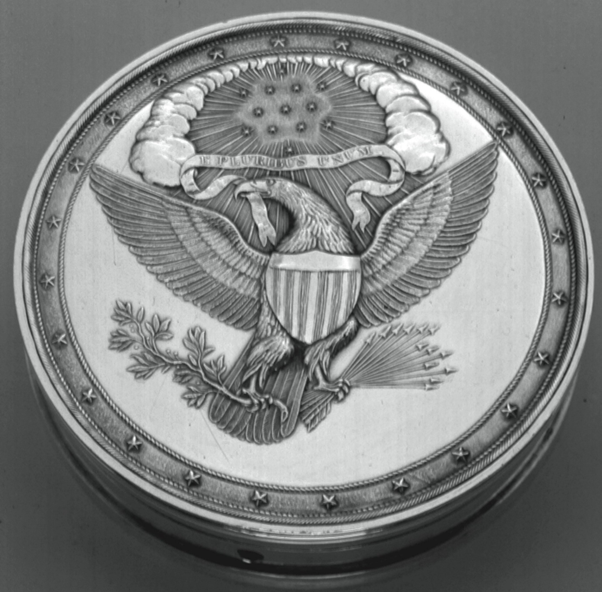
I realised that my date isn’t quite right but I like to think that this evolution was a gradual one and an eagle similar to this may have been carved onto the stern. There are numerous eagles of this style which can be found at the time. Below a great example:

One interesting quirk of the eagle of the constitution on the hull model is that it appears to be facing “sinister” (viewer right) the normal convention for the seal is for the eagle to be facing “dexter” viewer left. The eagle represented is somewhat unclear and it is possible that the item which appears to me to be the head and neck may well be the scroll it carries but who knows! The eagle does however face sinister from at least 1908 on the restored constitution so I went with this design.
Above the eagle I placed clouds carved from pear wood and a sphere above the eagle showing the 13 stars representing the 13 states. A little titbit of information is that there were already 17 states at this stage but that is neither here nor there.

On the corne painting it appears that there is some white in the area of the eagle, this could well be the banner the eagle holds. This also presented one of 2 opportunities to show that the decoration on the stern may well have been at least partially painted. I opted to paint this banner using white paint with a small amount of red to indicate the text, followed by a light brushing of yellow to blend the colour into the rest of the stern.

2: Lady Justice and 6: Lady Liberty
These elements were copied from baroque style art for their basic shape and carved in pear.
Lady justice holds a sword and mirrored shield with a mask below her feet.


Lady liberty holds a chalice feeding the eagle(another possible motivation for the sinister facing eagle) and she has a sword below her feet.
These ladies were painted yellow as with the rest of the elements but the shield was given a light white coat to show the mirrored shield.


Once all these parts had been glued to the transom with a combination of wood glue and CA glue the whole was spraypainted black using rustoleum matt black primer

9: Name “CONSTITUTION”
The name of the ship was apparently painted on the stern. There is limited evidence to work from so I simply copied a popular style from the time. This was a pretty laborious process but it was made easier by printing the name at the correct size and then taping it just above the place where the name should go. This allowed me to copy eat letter directly in its correct position. The font I used is called Castellar with a single space between letters. Its not perfect but good enough at a distance.

8: Window decoration painted
This little element isn’t too exciting, it was just another opportunity to show that the decoration of the stern may well have been a hybrid carving and painting scenario. These are meant to represent small “bows” used to tie the decorations to the arch close to the top of the window.

12: Hause Holes and wreath
The Hause holes were surrounded by wreaths made with the same technique as the outer window decorations. Their position was a subject of some debate and I moved them 3 times. Ultimately their final location was the result of a combination of practical considerations, historical evidence and aesthetics.

Final position on the vessel:
The final placement of the stern on the vessel was determined by looking at corne, hull and some other contemporary models.

This placement requited the removal of a small amount of the bulwark and removing the stern planking which was then glued directly to the transom to allow for the curvature of the stern. At a later date the taffrail will be installed, but that is a project for another day.

I think this post has only touched the surface of what was done on this portion of the build. If anyone would like more information about something specific or more detail on how the various parts were made please feel free to ask.
As always any comments or criticism is most welcome.
Kind regards
T.B.E.
-
1 hour ago, Der Alte Rentner said:
The plans that came with my model shipways kit are really beat up - especially page four around the top view near the bowsprit. The plans do not show any front views of the rails in that area. Only side views and that top view at the center of page four. What remains somewhat visible on my version of that plan suggests that the top rails do meet at the center of the bowsprit. In other words no gap. I think that's what I'm going to be going for. And I'm still debating on the notion of the flairs.
Did I say 5 years? Maybe six..
Would photos of the plans help at all? I am happy to try and take a few and send your way
- Unegawahya and Der Alte Rentner
-
 1
1
-
 1
1
-
1 hour ago, Der Alte Rentner said:
Is it just me or are the gun deck ports slightly concave vertically?
The Spar deck ports look great.
I couldn't ignore this observation. Some heavy sanding has leveled things out quite a bit and I'm hoping the planking will. Solve the rest.
I can't stress enough how much I appreciate the feedback. This is how one avoids looking at a model with 500 hours in it and realising you made a silly mistake at hour 20
Thanks Peter
Haiko

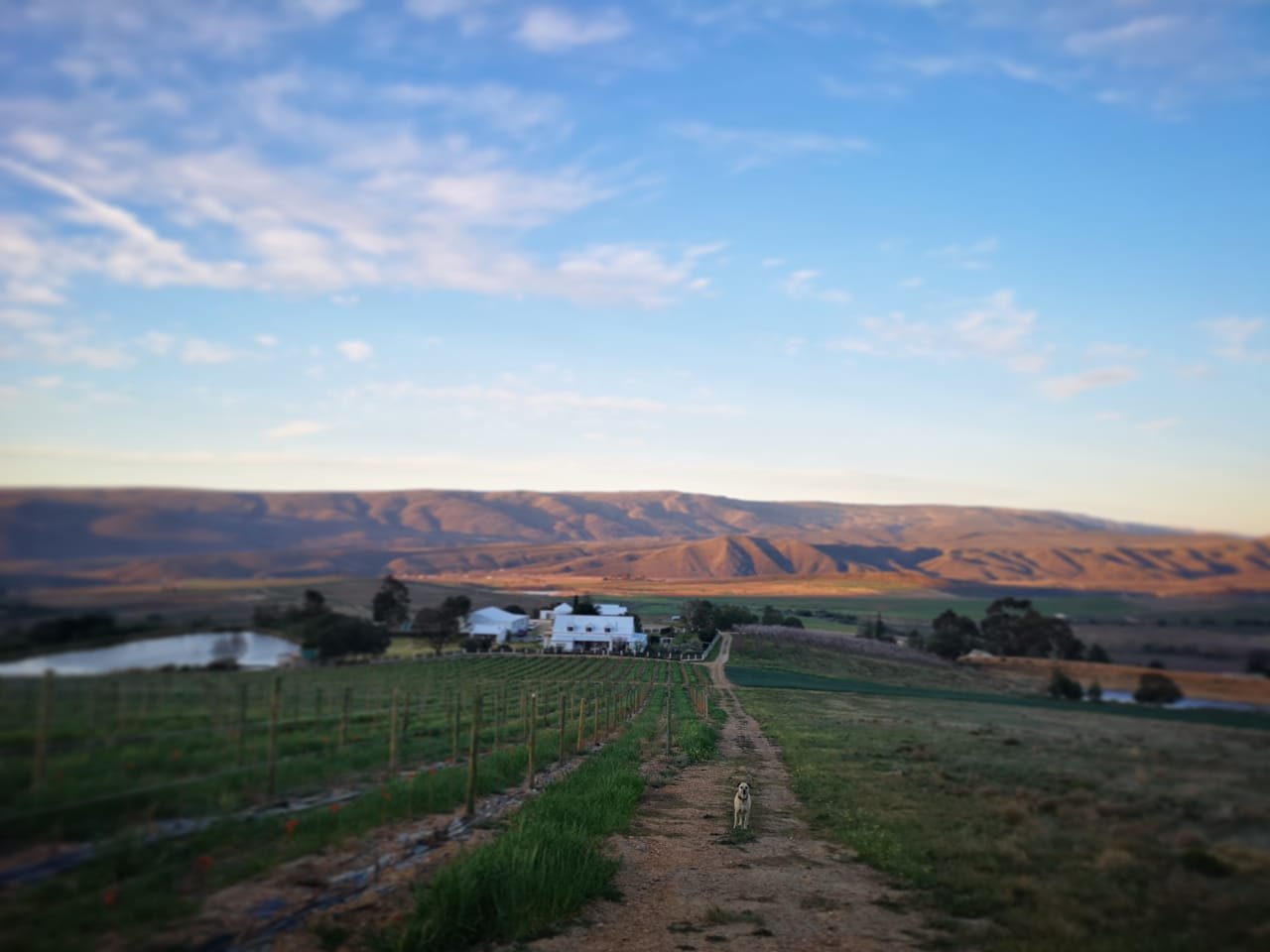

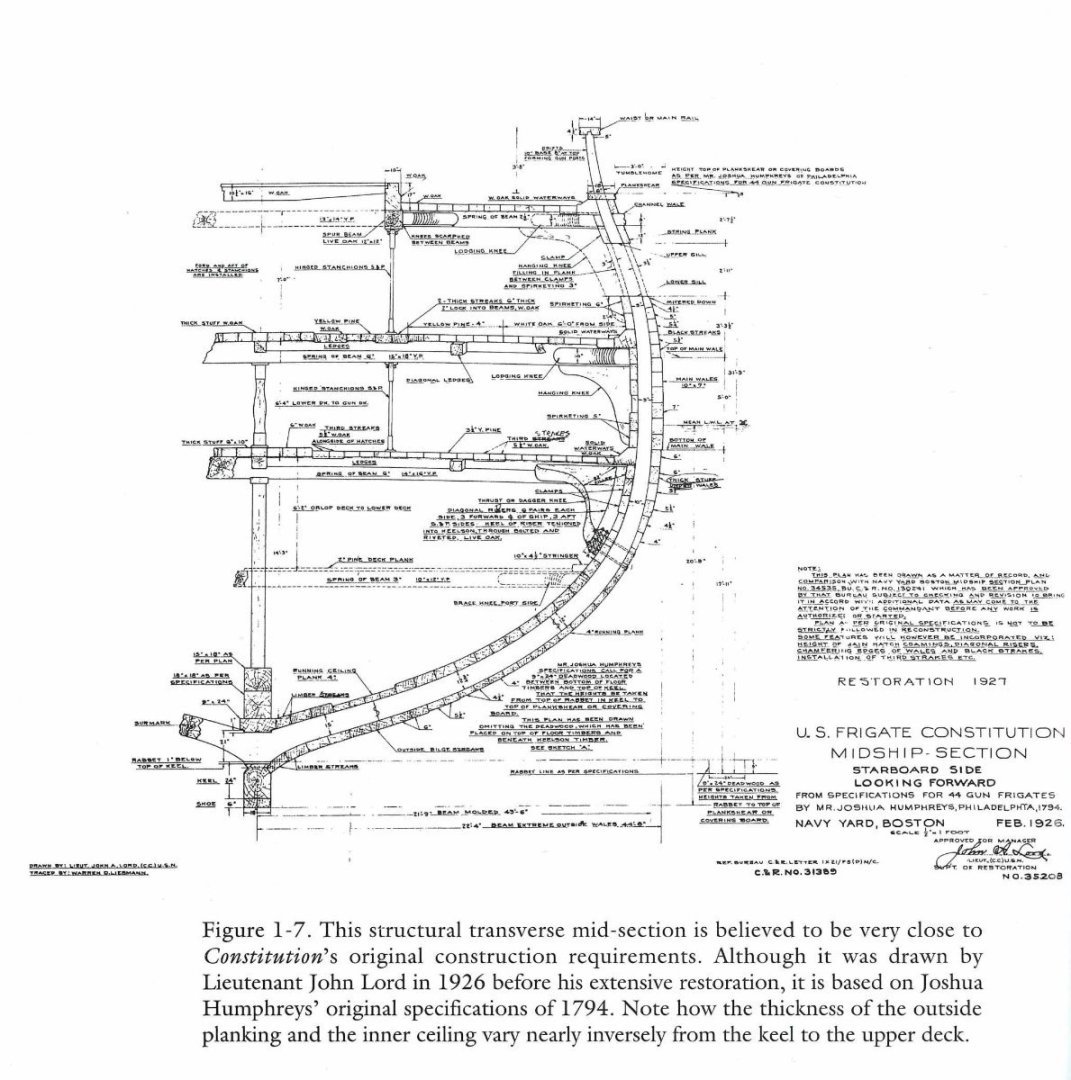
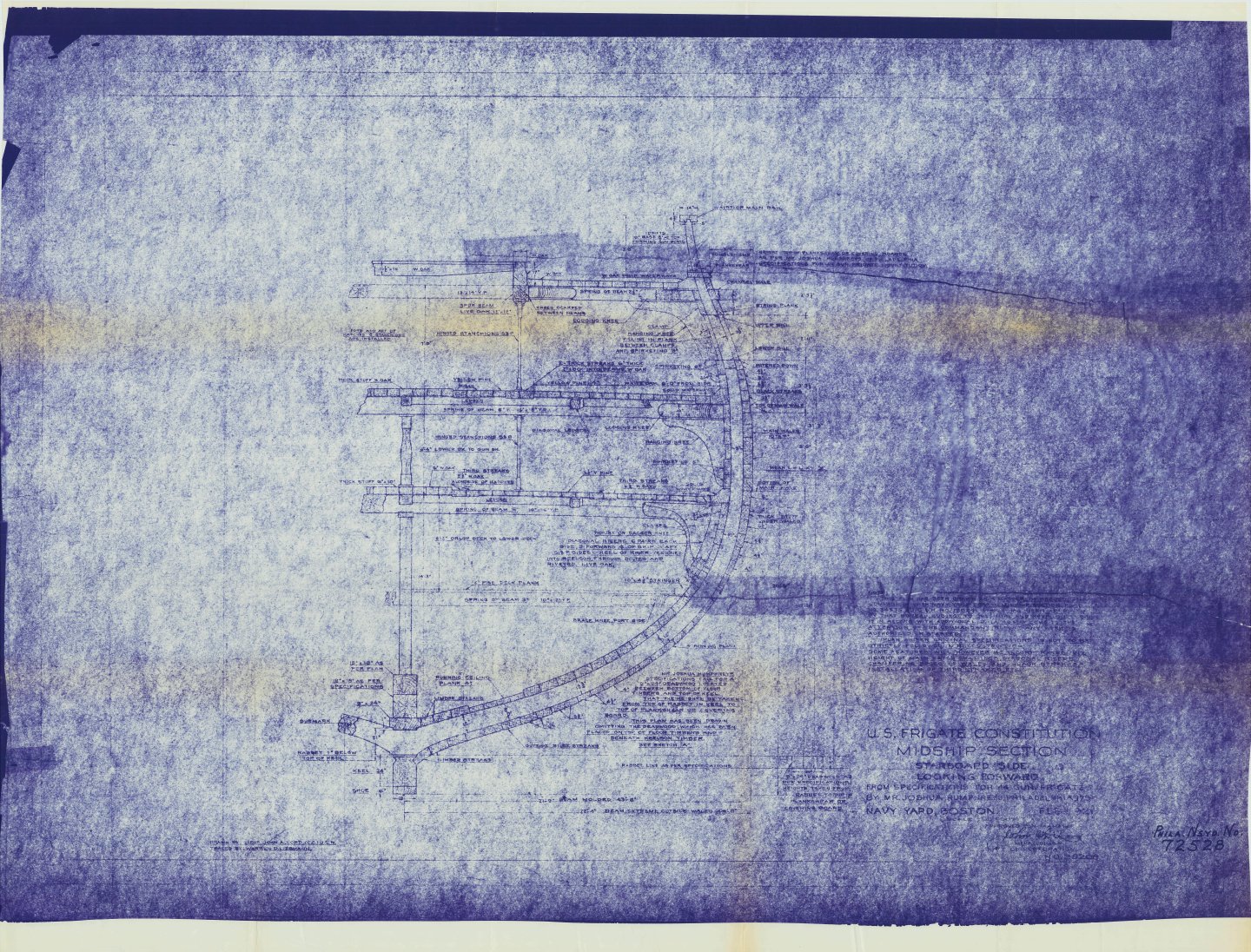
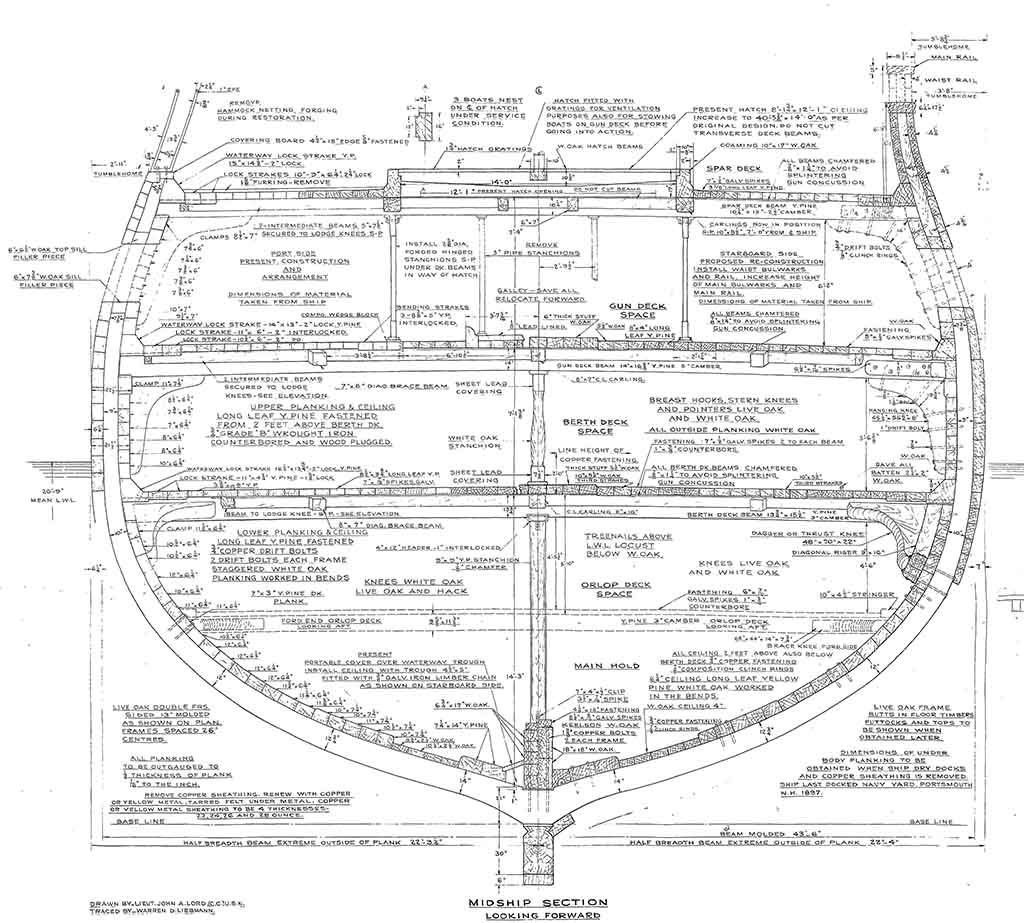
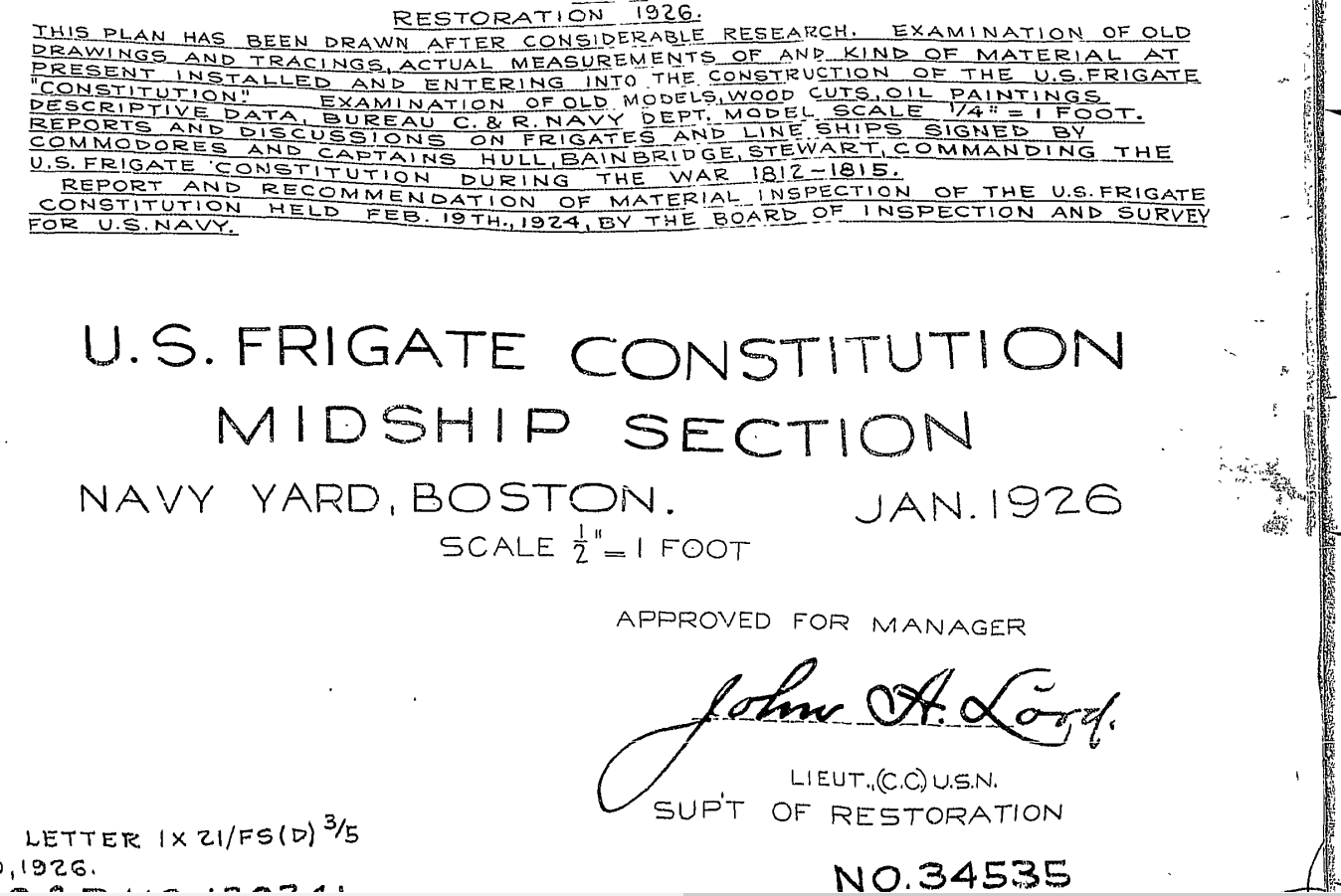
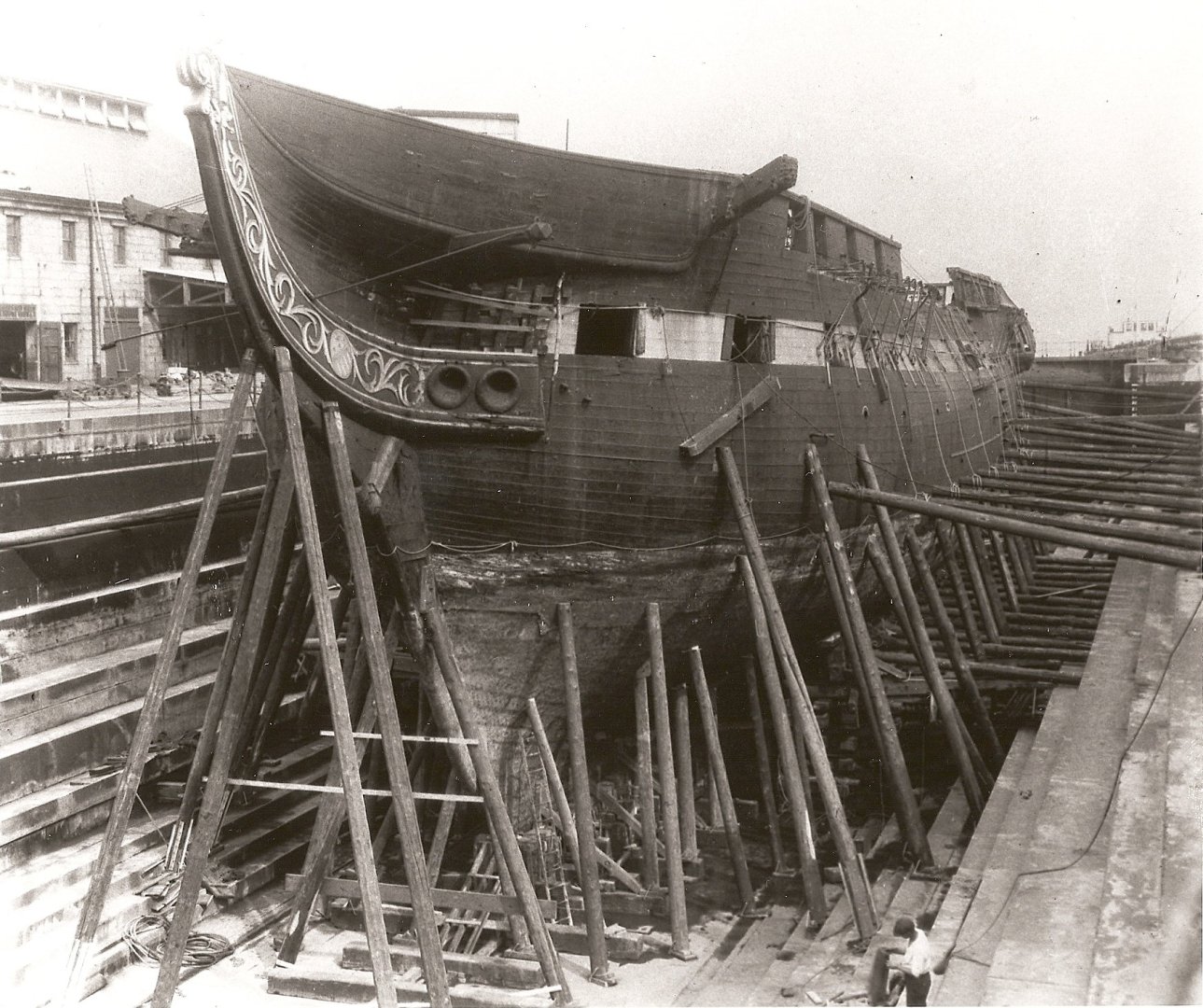
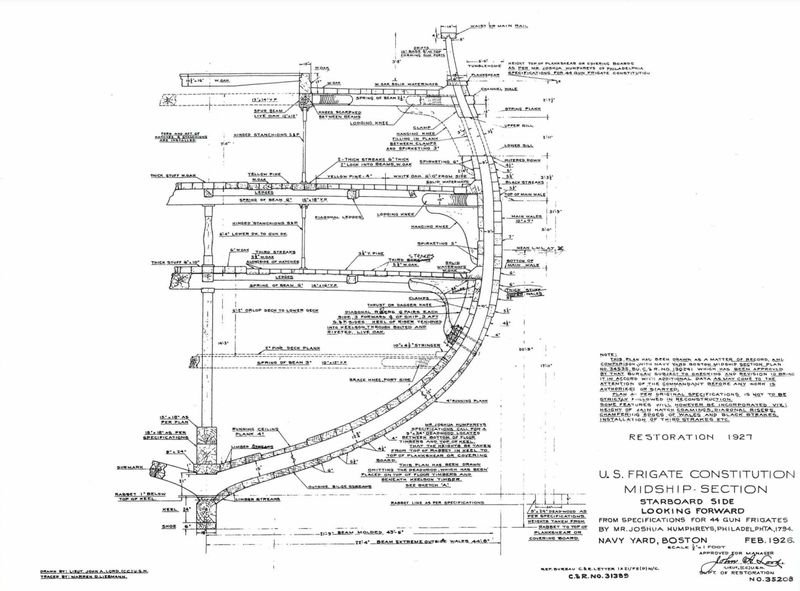
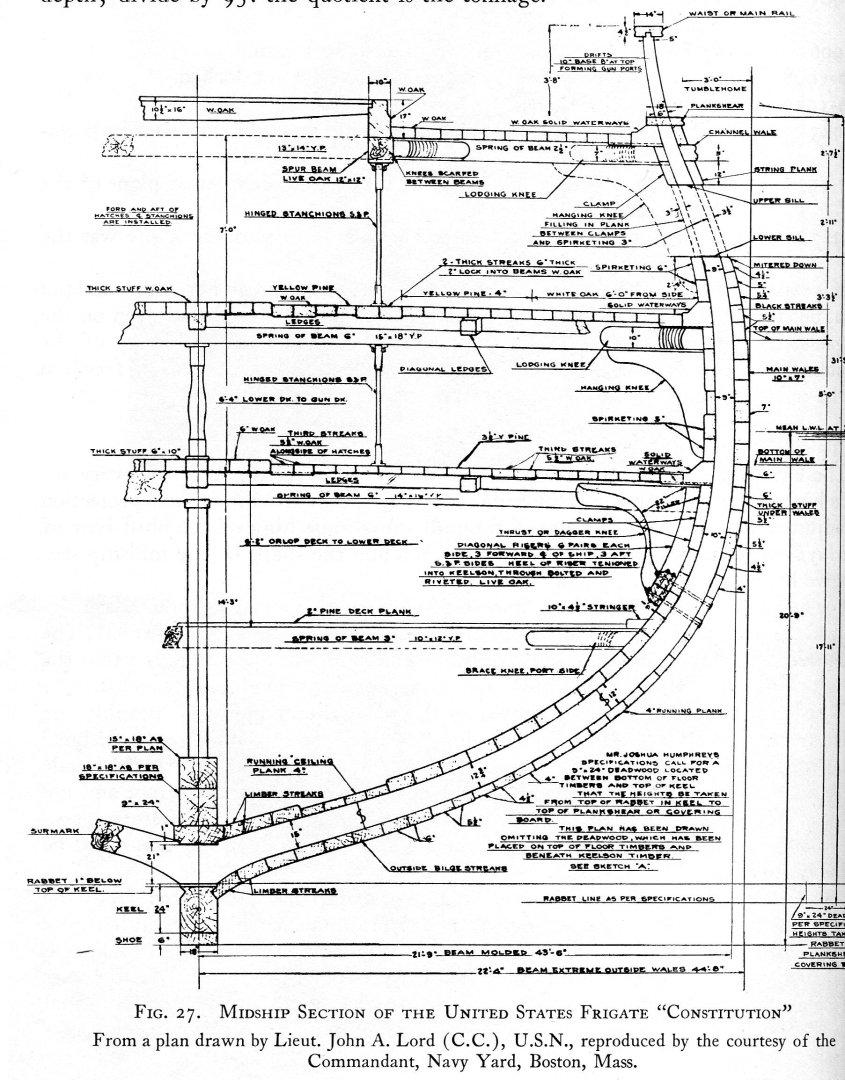
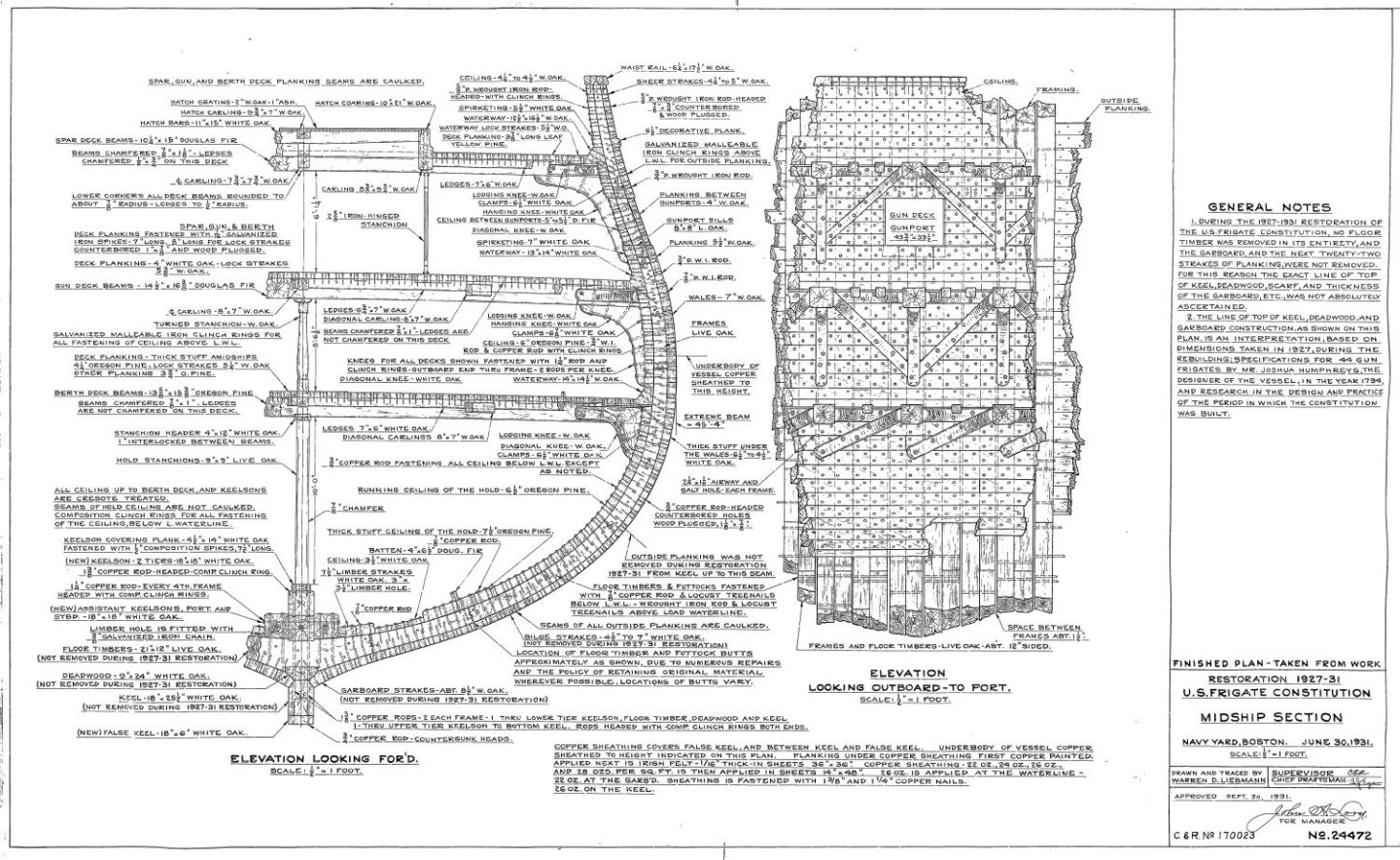
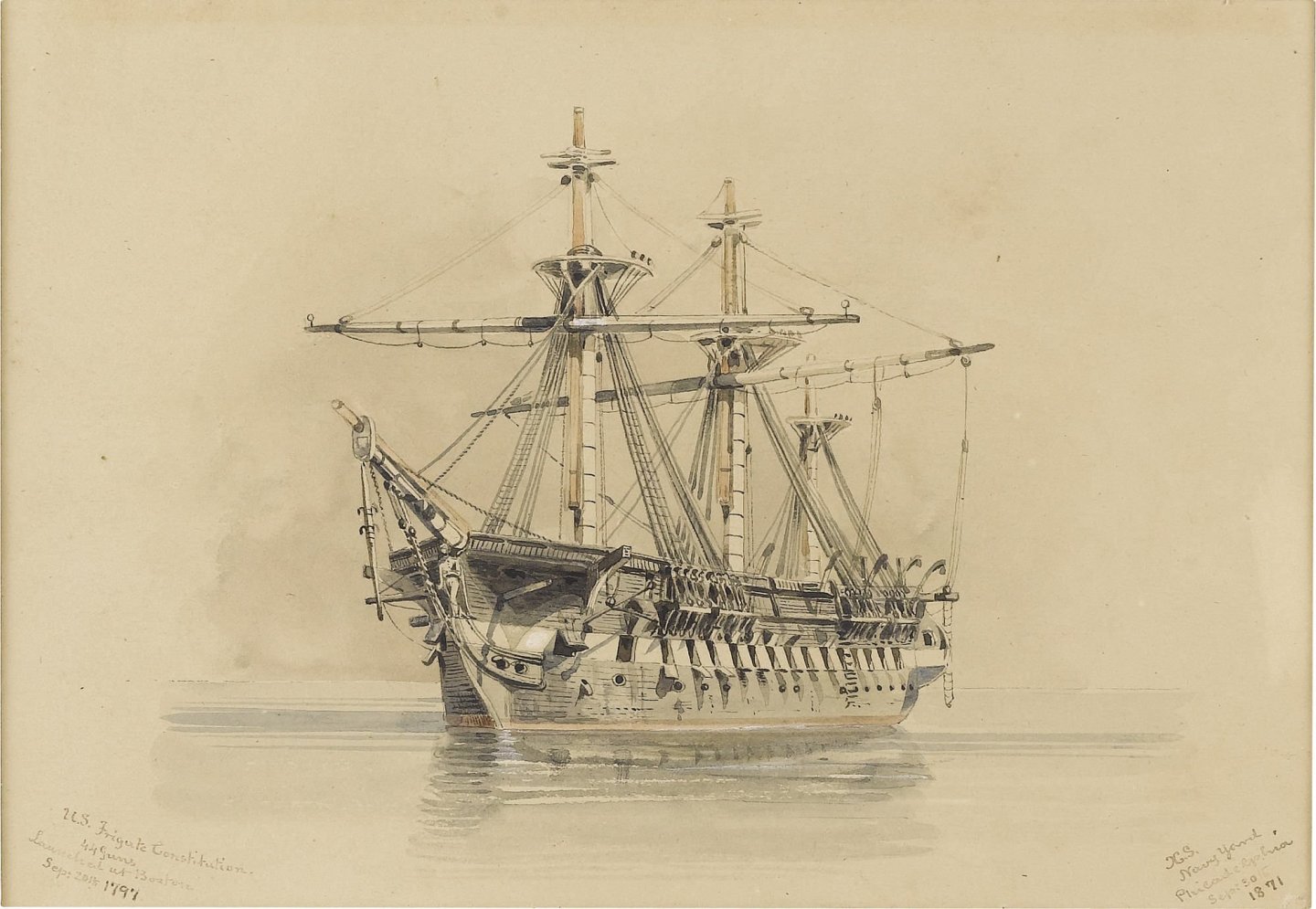
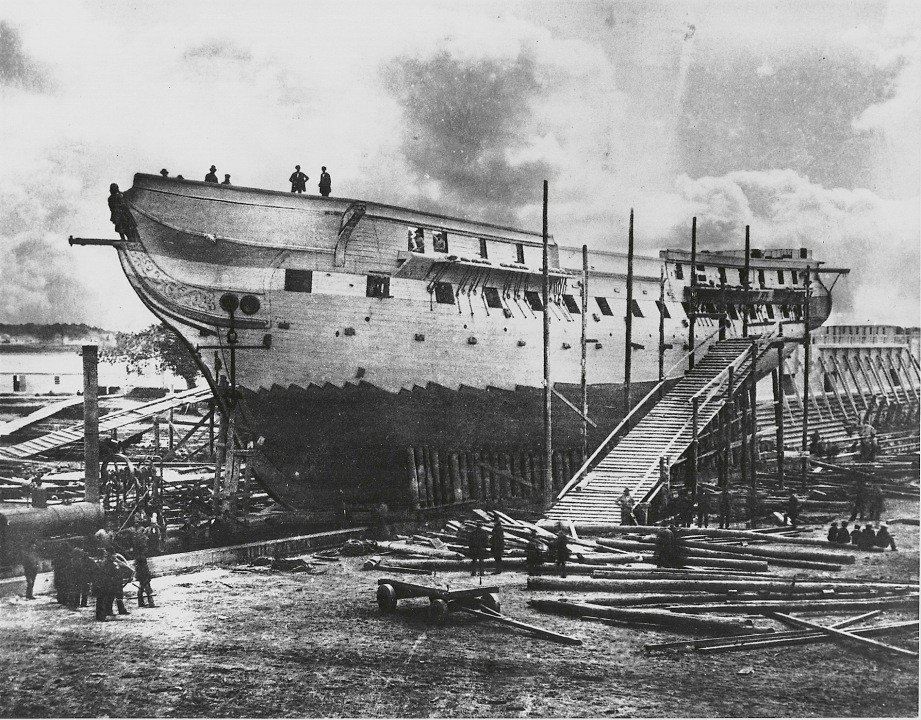
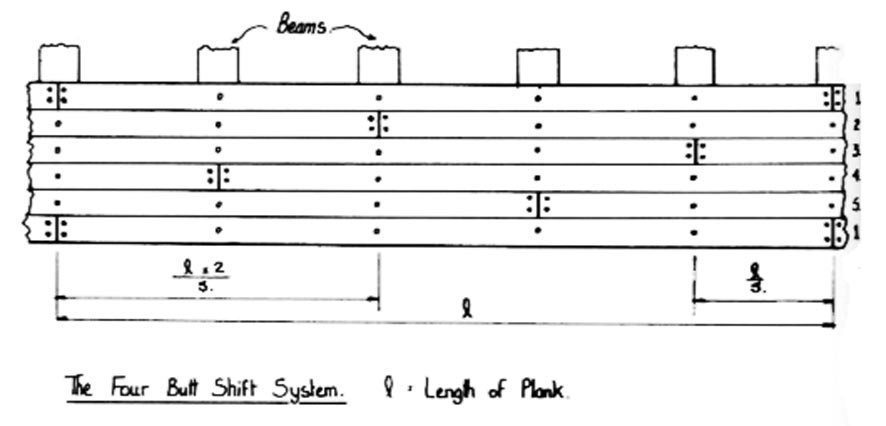
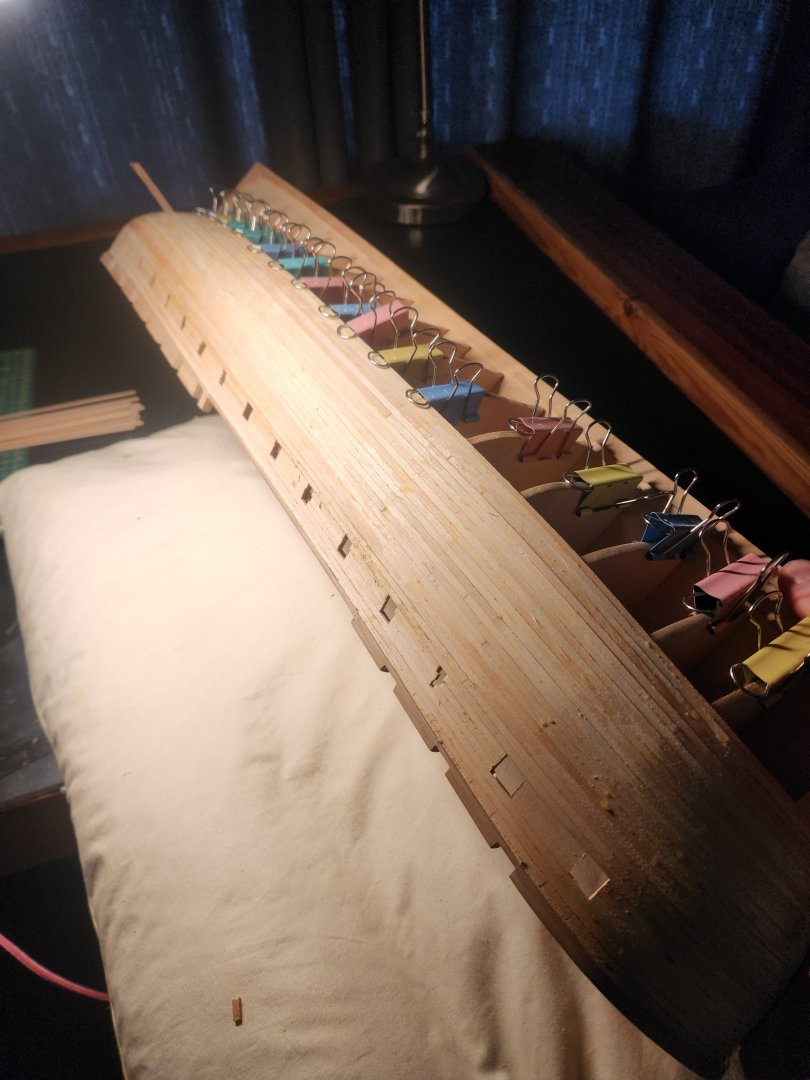
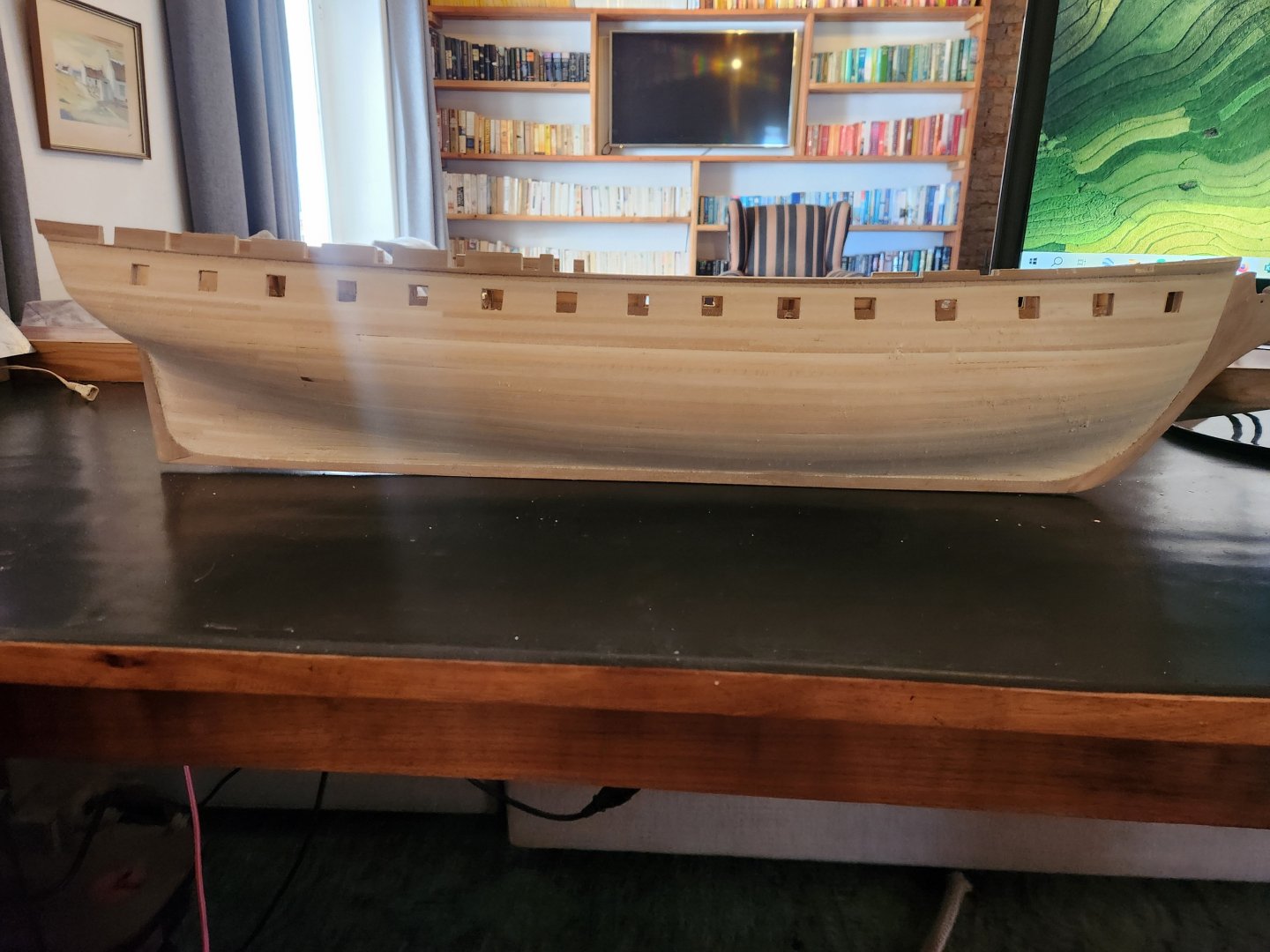
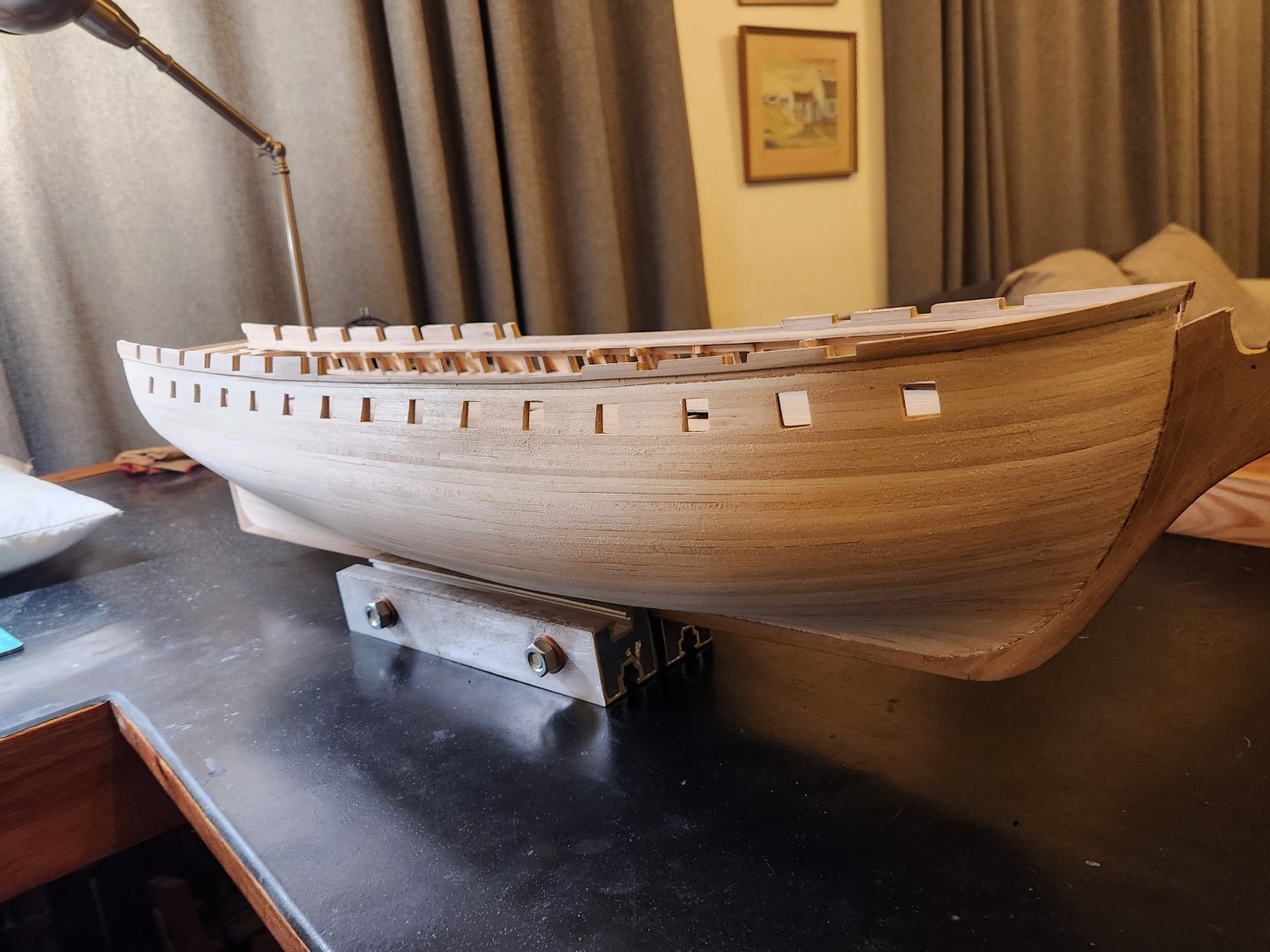
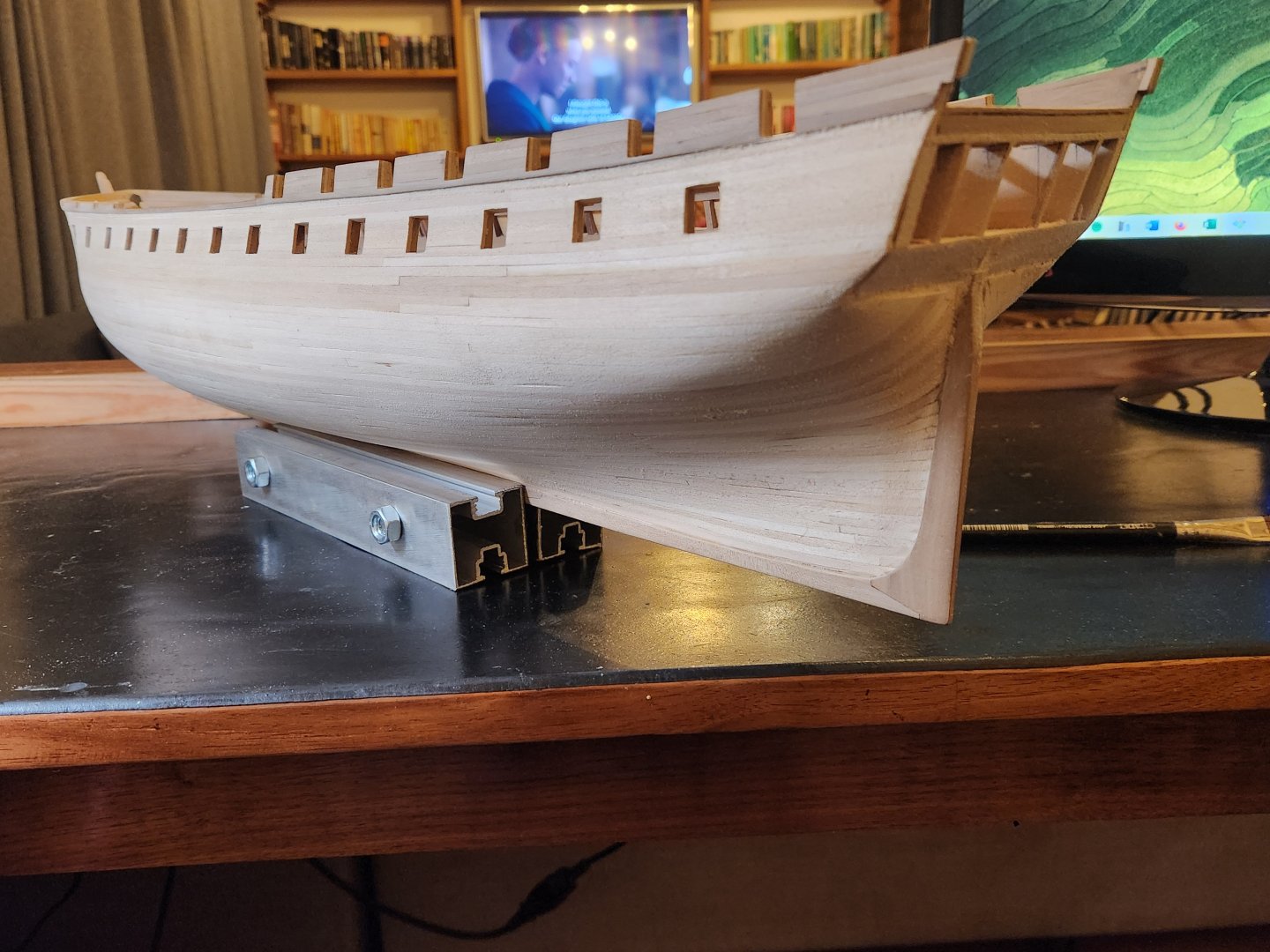

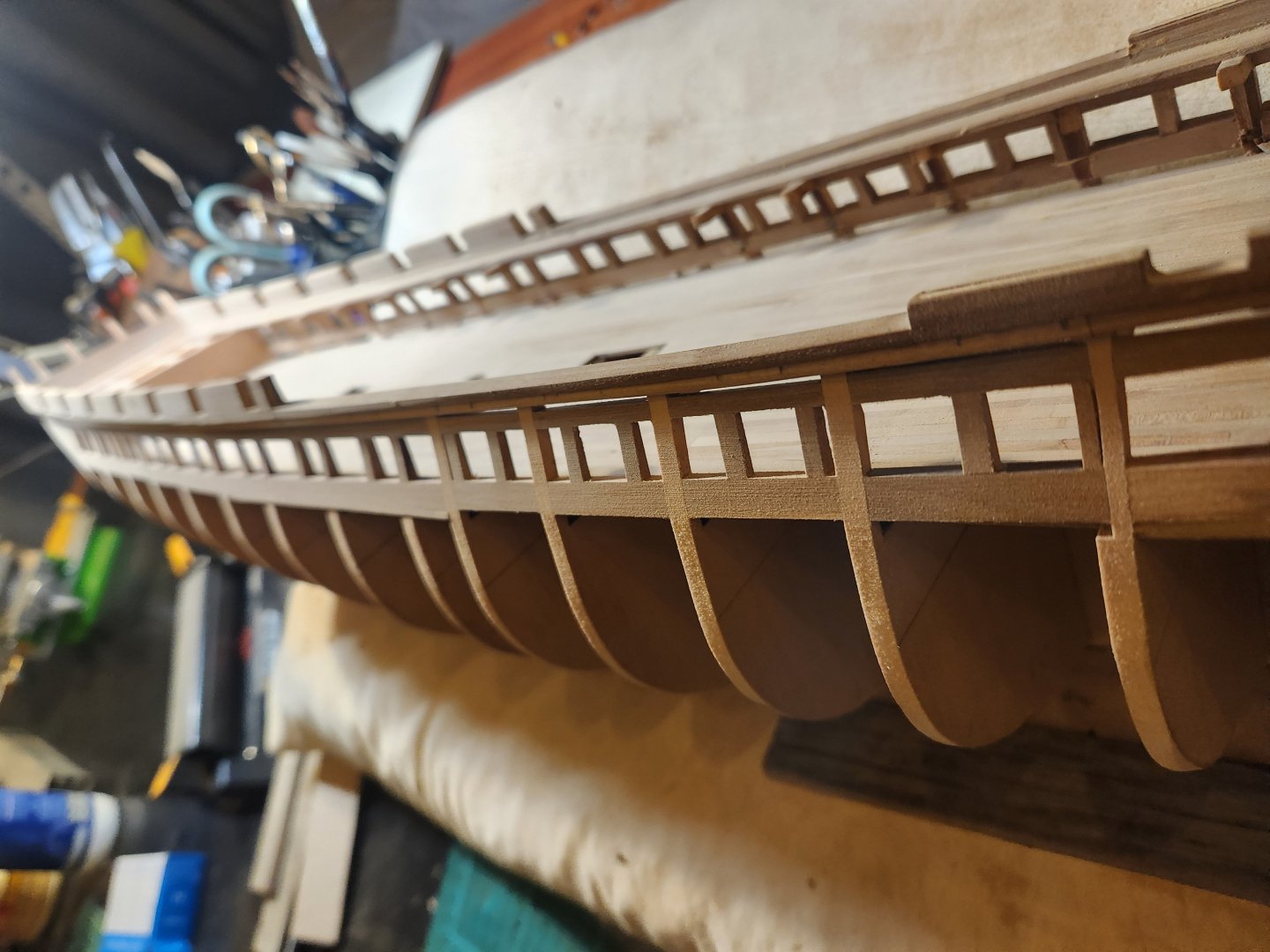
USS Constitution by The Bitter End - Model Shipways - 1:76
in - Kit build logs for subjects built from 1751 - 1800
Posted
A brief update on second planking progress.
I have decided to buy myself a little extra time before I have to make a final decision on the wales by planking down to where the Wale should begin and rough-sanding this back. This will give me the option to have a thicker squared, smooth or chamfered wale depending on what I decide.
For those that care I am leaning in the direction of doing a chamfered wale mostly because I would like the colour scheme to match that of the admiralty models and the Antczak model. This can be done with a smooth wale but I believe the paint effect will be better if the paint is applied to a slightly raised wale as opposed to a smooth hull. Below a photo of the scheme for referenc e. I realise this is a strange deviation for this drive for historical accuracy but I cannot bring myself to paint over the hand-cut pear planks.
Due to my lack of skill and the fact that I am cutting these planks on a 20-year-old 2kW table saw I really struggled to get consistent plank thicknesses. I therefore started very rough and over-thick and sanded back. The first planking allows for very effective pinning of the planks together to eliminate some of the smaller gaps.
A very rough result:
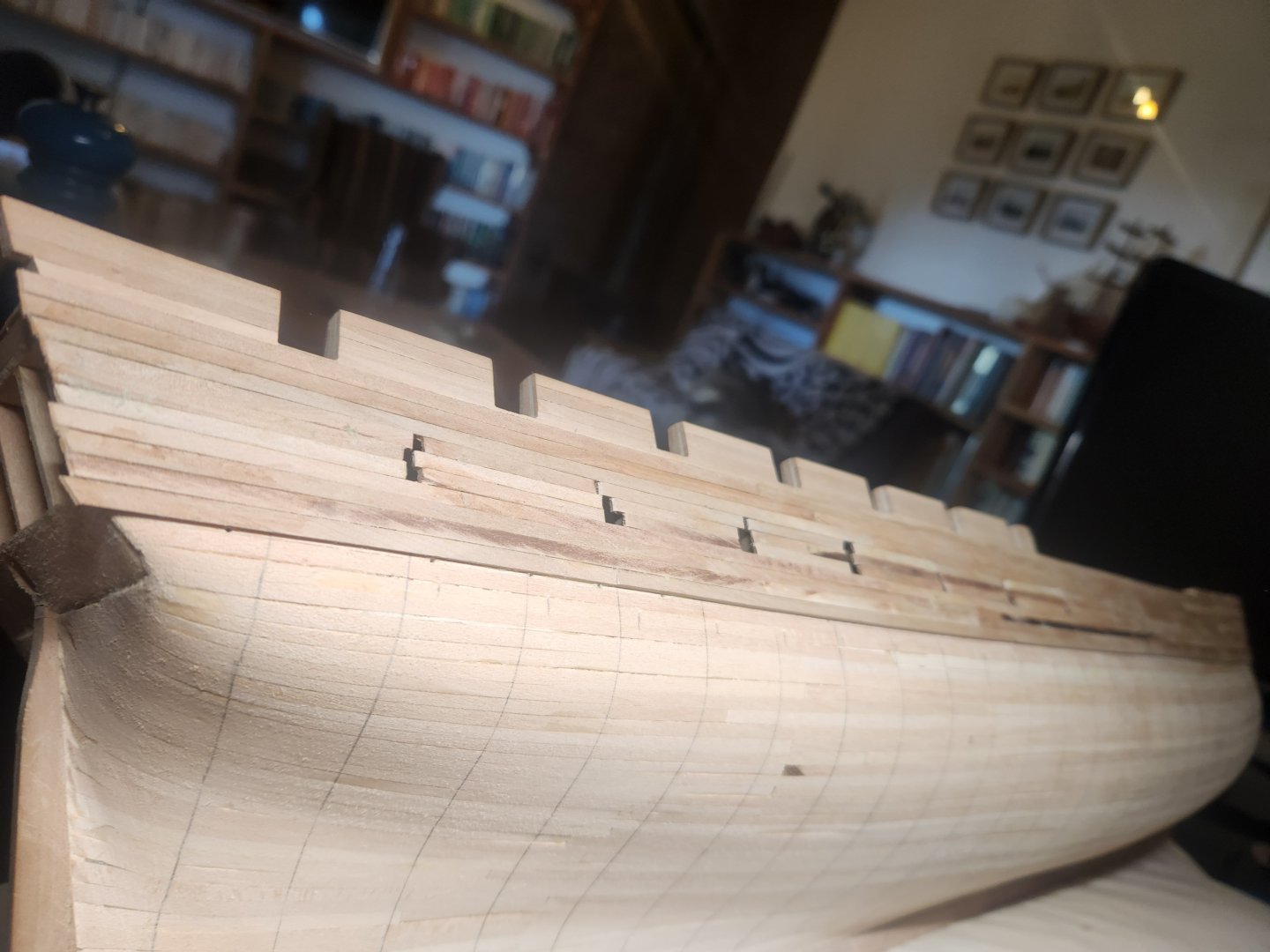
Which was largely remedied by rough sanding with 80 grit sandpaper. The finish is still rough-sanded and will later be sanded down to a far finer grit and sealed.
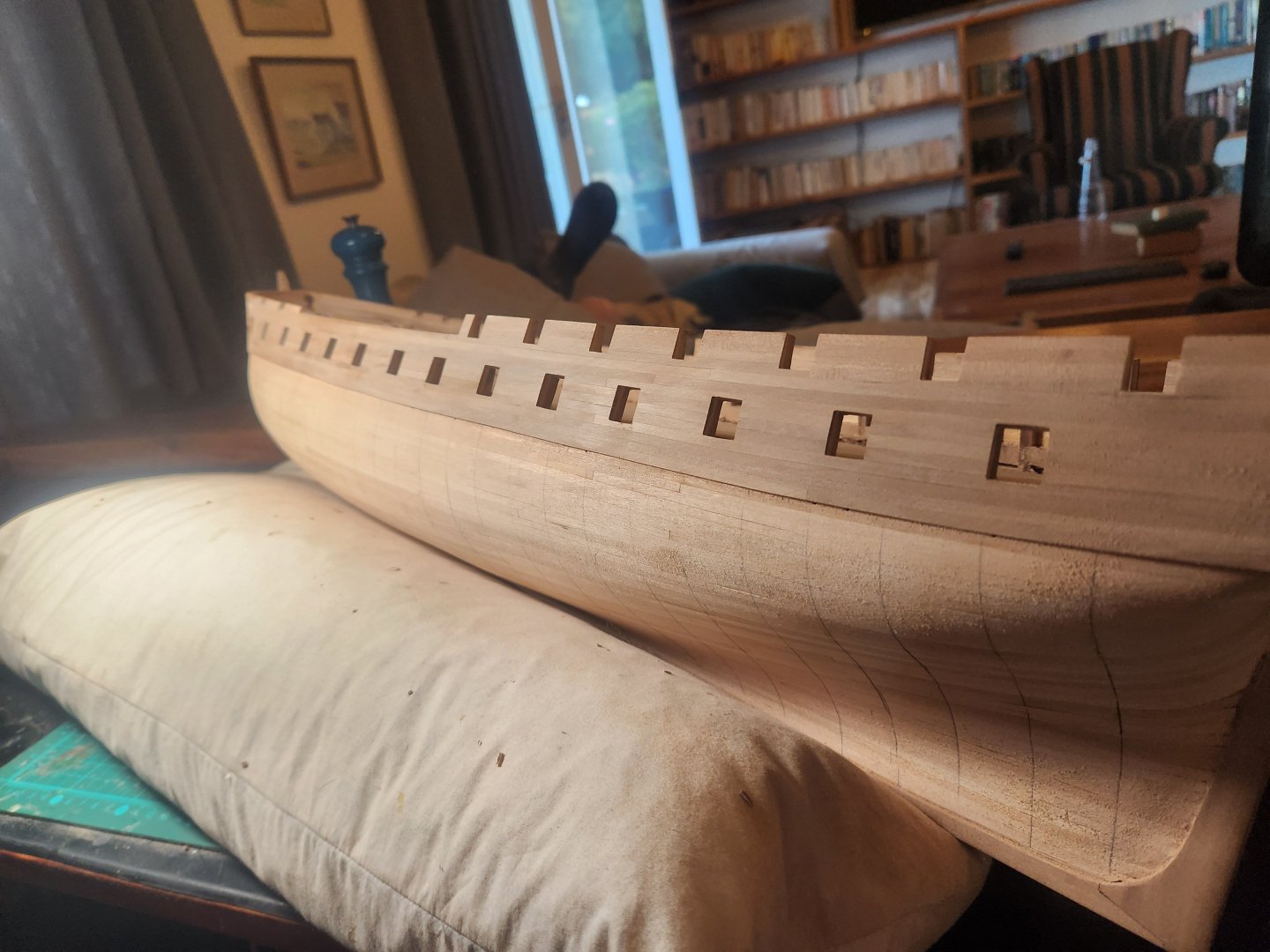
Any defects will also be filled with a sawdust and glue filler and the imperfections in the upper edge of the bulwark painted over as in the antczak model above and hidden under the planksheer strip so I am not too concerned about minor defects in these areas,
I hope to produce a far nicer result once this is all cleaned up properly so please don't judge too hard.
For those interested in the minutiae of my decision making process my planking was chosen as follows.
The average width was in the region of 10inches, there was some variation according to lords drawings but these are minor enough to not be worth replicating. This translated to a 3.3mm wide strip.
As for planking pattern and length, I went with a 4 butt shift pattern with the additional element of not allowing and butt to fall directly above or below a gun port it it was within 2 strakes of a gunport. The offset between butts was 6ft which I achieved by marking out the butt lines on the first planking at 24mm intervals and having butts land on these marks. This is a planking style which I got from HMS victory reconstruction specifications, I appreciate that this is not necessarily what wouldhave been used across the pond but its good enough for me in the absence of other information.
.jpg.e441bd31b706ce5e6bae4682232ff068.jpg.0a96b372483116ed10c8043c8c159057.jpg)
The records show that average hull plank length was around 40ft(159mm). I used this length as my baseline but always went upwards in plank length not downwards when a deviation from the 4 butt pattern was required. I chose to do this as a minor nod to the fact that American ship builders had access to far better timber resources than their European counterparts so I guessed they would have access to longer planks.
If anyone happens to want a copy of the planking spec I used feel free to give me a shout and ill send it over.
T.B.E.
PS. I just realised that I messed up the 4 butt shift. The last plank is incorrect and its butt advances 2 beams to the bow instead of moving 3 beams back. Luckily it is only one incorrect strake before I can "reset" the pattern below the wale planking. but I don't think I can justify removing that strake. If anyone has a way to justify my mistake please let me know. i know this error, no matter how invisible to most views, will bother me forever.